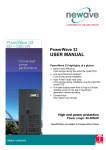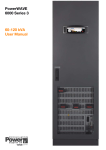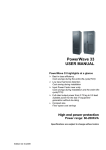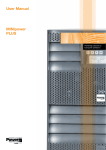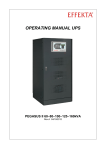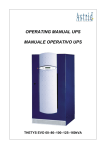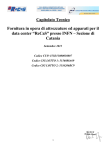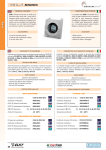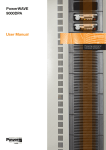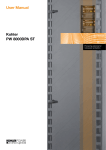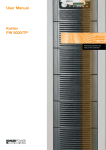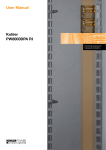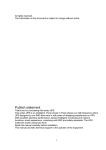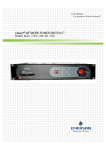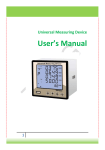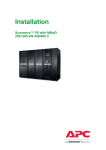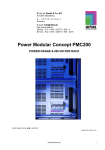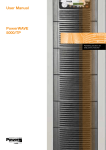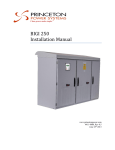Download 413-01-00 PW6000 60-500kVA User Manaual (UK).book
Transcript
User Manual Kohler PW 6000 Pioneering solutions for total power protection Document Control ISSUE DATE REVISION SUMMARY 1.0 02-05-12 Initial issue of 60-500kVA Manual 1.1 08-05-12 Minor typographic errors corrected 1.2 25-06-12 Minor typographic errors corrected and new Lexan inserted in Ch-4 UPS413-01-00 Kohler PW 6000 (60-500kVA) User Manual 25 June 2012 Kohler Uninterruptible Power has taken every precaution to produce an accurate, complete and easy to understand manual and will therefore assume no responsibility nor liability for direct, indirect or accidental personal or material damage due to any misinterpretation of or accidental mistakes in this manual. © 2010 Kohler Uninterruptible Power This manual may not be copied nor reproduced without written permission of Kohler Uninterruptible Power. UPS413-01-00 Kohler PW 6000 (60-500kVA) User Manual 25 June 2012 Table of Contents 1 Safety 1.1 Description of symbols used in this manual 1.2 User precautions 2 Description 2.1 Introduction 2.1.1 Reliability and quality standards 2.1.2 Key features 2.2 Kohler PW 6000 Model range 2.2.1 Single/Parallel system configurations 2.3 Kohler PW 6000 functional description 2.3.1 Kohler PW 6000 block diagram 2.3.2 UPS internal operating modes 2.3.3 System operating modes 2.3.4 Multi-cabinet parallel system concept 2.4 Warranty 2.5 Extended warranty 2.6 Additional service/maintenance support 3 1-1 1-1 2-1 2-1 2-1 2-2 2-2 2-2 2-3 2-3 2-5 2-5 2-7 2-8 2-8 Installation 3.1 Introduction 3.2 Taking receipt of the UPS 3.2.1 Site transportation 3.3 Unpacking 3.4 Storage 3.5 Planning the installation (site considerations) 3.5.1 Clearances 3.6 Planning the installation (cabling considerations) 3.6.1 General requirements 3.6.2 Cable and fuse sizing 3.6.3 Power cable terminations 3.6.4 Power cabling in a parallel system 3.7 UPS Cabling procedure 3.7.1 Connecting the input cables 3.7.2 Connecting the UPS output cables 3.8 Battery connections 3.8.1 ‘Sidecar’ battery enclosure (60-100kVA) 3.8.2 Remote battery enclosure 3.8.3 Connecting the batteries 3.9 Multi-module control cabling and configuration 3.9.1 Connecting the parallel communication bus cables 3.9.2 Configuration DIP switch selection 3.9.3 Module communications interface facilities UPS413-01-00 Kohler PW 6000 (60-500kVA) User Manual 25 June 2012 3-1 3-1 3-1 3-2 3-2 3-3 3-3 3-4 3-4 3-5 3-8 3-10 3-11 3-11 3-12 3-17 3-17 3-18 3-18 3-18 3-18 3-19 3-20 i 4 Operation 4.1 Commissioning 4.2 UPS Control panel 4.2.1 Power Management Display (PMD) 4.2.2 Mimic LED indicators 4.2.3 Operator keys 4.3 Description of the LCD display 4.3.1 Status screens 4.3.2 Main menu screen 4.3.3 Event log menu screen 4.3.4 Measurements menu screen 4.3.5 Commands menu screen 4.3.6 UPS Data menu screen 4.3.7 Set-up user menu screen 4.3.8 Set-up service menu screen 4.4 Operating instructions 4.4.1 Starting the UPS system from the maintenance bypass 4.4.2 Individual module start/stop procedure 4.4.3 Transfer to maintenance bypass mode 4.4.4 Complete system shutdown 5 Maintenance 5.1 5.2 5.3 5.4 6 Introduction User responsibilities Routine maintenance Battery testing 5-1 5-1 5-1 5-2 Troubleshooting 6.1 Alarms 6.2 Menu, Commands, Event Log, Measurements, 6.2.1 Event log screen 6.2.2 Fault identification and rectification messages and alarms 6.3 Contacting service 7 Introduction Serial RS232 Computer interface – USB & JD1 (Smart Port) RS485 Interface for multidrop – JR1 (JR2 for 400-500kVA) Dry ports customer interface (X1, X1, X3) 7.4.1 60-300kVA Model interface connections 7.4.2 400-500kVA Customer interface connections 7.4.3 Remote emergency stop option 7.4.4 Generator ON facilities 7.4.5 SNMP Card slots 7.5 UPS Monitoring and automated control software 7.5.1 SNMP monitoring software 7.5.2 WAVEMON UPS monitoring and control software 7.5.3 PowerREPORTER™ management software 7-1 7-2 7-2 7-3 7-3 7-4 7-5 7-6 7-6 7-7 7-7 7-7 7-8 Specifications 8.1 General specifications 8.2 60-300kVA Fuses & cables quick reference 8.3 400-500kVA Fuses & cables quick reference ii 6-1 6-1 6-1 6-2 6-3 Options 7.1 7.2 7.3 7.4 8 4-1 4-1 4-1 4-2 4-2 4-3 4-3 4-4 4-4 4-4 4-5 4-5 4-6 4-6 4-7 4-7 4-9 4-10 4-12 8-1 8-6 8-7 UPS413-01-00 Kohler PW 6000 (60-500kVA) User Manual 25 June 2012 1 1.1 Safety Description of symbols used in this manual WARNING: The warning symbol is used where there is danger of an electrical shock, equipment damage or personal-injury. CAUTION: The caution symbol is used to highlight important information to avoid possible equipment malfunction or damage. 1.2 User precautions WARNING: Keep this manual with the UPS for future reference. WARNING: The UPS and peripheral equipment must be installed and commissioned by suitably qualified and trained personnel who are aware of the potential shock hazards. WARNING: Do not attempt to install this UPS system until you are satisfied that ALL the safety instructions and hazard warnings contained in this manual are read and fully understood. WARNING: High leakage current! Ensure that the UPS has been correctly earthed before you connect the mains power supply! WARNING: This UPS must not be started-up or put into use without having first been commissioned by a fully trained engineer authorised by the manufacturer. WARNING: This UPS must be serviced by qualified personnel. You run risk of exposure to dangerous voltages by opening or removing the UPS-covers! Uninterruptible Power Supplies Ltd will assume no responsibility nor liability due to incorrect operation or manipulation of the UPS. WARNING: The Kohler PW 6000 is a Class A UPS product (according to EN 62040-3). In a domestic environment the UPS may cause radio interference. In such an environment the user may be required to undertake additional measures. UPS413-01-00 Kohler PW 6000 (60-500kVA) User Manual 25 June 2012 1-1 1: Safety 1-2 UPS413-01-00 Kohler PW 6000 (60-500kVA) User Manual 25 June 2012 2 2.1 Description Introduction Congratulations on your purchase of the Kohler PW 6000 UPS. Continuous power availability is essential in today’s dynamic IT and process-related work environments. It is equally important that any installed power protection system is sufficiently resilient and adaptable to handle any changes brought about by the introduction of new server technologies, migration and centralization. Such demands are well met by the Kohler PW 6000 UPS system, which provides the foundation for continuous power availability of network-critical infrastructures both in enterprise data centres, where business continuity has paramount importance, and in process control environments where manufacturing continuity is essential. 2.1.1 Reliability and quality standards The Kohler PW 6000 UPS is available over a model range of 60kVA to 500kVA and incorporates the latest technological developments in power engineering. Representing a completely new generation of high power three phase UPS systems, its advanced double conversion VFI (Voltage and Frequency Independent) topology responds fully to both the highest availability and environmentally friendly requirements compliant with IEC 62040-3 (VFI-SS-111) standards. High reliability, upgrade ability, low operating costs and excellent electrical performance are only some of the highlights of this innovative UPS solution. Kohler Uninterruptible Power specialises in the installation and maintenance of Uninterruptible Power Systems; and this powerful UPS is just one example of our wide range of state-of-the-art power protection devices that will provide your critical equipment with a steady and reliable power supply for many years. 2.1.2 Key features The highlights of this innovative UPS solution include its high reliability, upgrade ability, low operating costs and excellent electrical performance. KEY FEATURES Compact size, small foot print Space saving on expensive floor space Flexible battery management Advanced management of battery charging and preventive failure diagnostics avoids premature deterioration of battery life. Best in class ac-ac efficiency, up to 96% Energy-Operational cost savings (TCO) Low input power factor (near unity) Cost savings during installation and the entire life cycle (TCO) Blade-server-friendly power; full power from 0.9 lead to 0.9 lag No de-rating required with leading PF loads Very low input current distortion THDi THDi = < 3.5% @ 100% load Gen-set power and installation cost saving UPS413-01-00 Kohler PW 6000 (60-500kVA) User Manual 25 June 2012 2-1 2: Description 2.2 Kohler PW 6000 Model range The Kohler PW 6000 UPS range includes 60, 80, 100, 120, 160, 200, 250, 300, 400 and 500kVA models. Models in the 60-100kVA range are available in three cabinet sizes, two of which incorporate internal battery housings. Modules greater than 100kVA require the UPS batteries to be mounted in a separate battery enclosure or mounted on a purpose-designed battery rack. A range of optional battery closures are available. For a complete description of the various cabinets’ weight and dimensions see Chapter 8 (Specifications). 2.2.1 Single/Parallel system configurations The Kohler PW 6000 UPS can be configured to operate as a single, stand-alone UPS or several (up to 10) UPS cabinets can be connected in parallel to operate as a multi-module UPS system. A multi-module configuration is generally chosen either to increase a system’s total power capacity or to increase the system’s overall reliability by providing a degree of module redundancy. Note: In this manual the terms ‘multi-module system’ and ‘parallel system’ are synonymous. Parallel system operation When operating as part of a parallel UPS system it is critical that various control functions such as load sharing, frequency synchronisation and load transfer are observed by all the connected UPS modules. In the Kohler PW 6000 UPS system this is achieved by a parallel control bus which allows all the connected modules to communicate with each other and carry out the necessary synchronous control operations. Due to its Decentralised Parallel Architecture (DPA) design each Kohler PW 6000 UPS can take the leadership role when operating in a multi-module system. This avoids single points of failure in the parallel chain once again ensure the highest level of power availability. Parallel system expansion Most data centres present a low initial power demand which increases as the data centre grows to its full capacity; and it is essential that the installed power protection system can be expanded to meet the growing demand without compromising the existing load. This situation is easily managed in a Kohler PW 6000 multimodule installation which allows an additional module to be connected to an existing parallel system without having to temporarily transfer the load to the raw mains (by-pass) supply. Thus the load still receives UPS protected power at all times during the upgrade process – without interruption. Key Point: All the UPS modules connected to a parallel system must be of the same power rating. 2.3 Kohler PW 6000 functional description MAINTENANCE BYPASS LINE Bypass Supply STATIC BYPASS LINE 2 5 STATIC SWITCH Mains Supply 1 RECTIFIER INVERTER IA1 4 Load Supply IA2 3 Charger BATTERY UPS MODULE Figure 2.1 Kohler PW 6000 UPS block diagram 2-2 UPS413-01-00 Kohler PW 6000 (60-500kVA) User Manual 25 June 2012 2: Description 2.3.1 Kohler PW 6000 block diagram Figure 2.1 shows the power blocks contained within the Kohler PW 6000 UPS. UPS Input supplies The Mains supply (1) is a three phase supply which is connected to the UPS rectifier. During normal operation this supply is rectified to provide a DC input to the inverter and also charges the battery. A separate mains supply (2) is shown connected to the static bypass in Figure 2.1; however in a standard UPS module the bypass supply terminals (2) are usually linked to the mains supply terminals (1) so the UPS effectively requires only a single mains supply connection. (See paragraph 3.6.2 for details concerning ‘Single Feed’ & ‘Dual Feed’ input supply configurations.) The bypass supply is shown connected to the static switch (4) and the maintenance bypass line (5). UPS Output (load) supply Figure 2.1 shows that the UPS output (Load supply) can be provided through one of three power paths from within the UPS, depending on the UPS operating mode: • From the inverter (3), via the static switch and isolator IA2 • From the static bypass line (4) via the static switch and isolator IA2 • From the maintenance bypass line (5) via the maintenance bypass isolator IA1 The criteria for operating under each of these UPS modes is described below. 2.3.2 UPS internal operating modes Load on Inverter This is the normal operating mode and the only one that provides the load with continuously processed and backed-up power. In this mode, the mains supply is converted to DC by the rectifier which then charges the battery and provides operating power for the inverter; which converts the rectifier output back to AC suitable to provide the load power. If the mains supply fails or strays outside a preset voltage range, the rectifier shuts down and the battery provides an alternative DC power source for the inverter; which continues to operate until the battery is discharged. MAINTENANCE BYPASS LINE Bypass Supply IA1 STATIC BYPASS LINE STATIC SWITCH Mains Supply RECTIFIER Load Supply IA2 INVERTER Charger BATTERY UPS MODULE MAINTENANCE BYPASS LINE Bypass Supply IA1 STATIC BYPASS LINE STATIC SWITCH Mains Supply RECTIFIER Load Supply IA2 INVERTER Charger BATTERY UPS MODULE Figure 2.2 Load on inverter UPS413-01-00 Kohler PW 6000 (60-500kVA) User Manual 25 June 2012 2-3 2: Description When operating in the ‘Load on Inverter’ mode the inverter output frequency is synchronised to the bypass supply provided the bypass supply frequency remains within preset limits. If these limits are exceeded, or if the bypass supply fails altogether, the inverter frequency control reverts to a free-running oscillator that will maintain the output frequency at a constant 50/60Hz. When operating from battery power various alarms are generated at preset voltages as the battery discharges. This enables the operator to shut-down the load in an orderly manner (e.g. save data) before the battery reaches its end-of-discharge voltage. Various options are available to automate the load shut-down process, as described in Chapter 7 of this manual (Options). Load on Bypass In the ‘Load on Bypass’ mode the load supply is connected to the unprocessed static bypass line via the static switch. When operating in this mode the rectifier, charger and inverter sections can be turned off entirely or remain running, and continue to provide battery charging. MAINTENANCE BYPASS LINE Bypass Supply IA1 STATIC BYPASS LINE Load Supply STATIC SWITCH Mains Supply RECTIFIER IA2 INVERTER Charger BATTERY UPS MODULE Figure 2.3 Load on bypass Inverter/Bypass load transfer As illustrated in the above diagrams, the load is connected to the inverter or static bypass power circuits by means of the static switch. This is a solid state switch which is operated by the UPS microprocessor control system and allows the inverter/bypass operating mode to be selected manually via the UPS operator control panel or automatically depending on various UPS operating conditions (see paragraph 2.3.3). Load on Maintenance Bypass In this mode of operation the manually closed maintenance bypass switch connects the load supply directly to the unprocessed bypass supply. This is used to keep the load supplied (albeit without any power protection) whilst allowing the remainder of the UPS to be shut down for service repair. MAINTENANCE BYPASS LINE Bypass Supply IA1 STATIC BYPASS LINE Load Supply STATIC SWITCH Mains Supply RECTIFIER IA2 INVERTER Charger BATTERY UPS MODULE Figure 2.4 Load on maintenance bypass Note: Live voltages are still present on the UPS input and output power terminals when in this mode. To prevent possible inverter damage, it is important that the inverter output and maintenance bypass lines are never connected in parallel. Therefore when transferring from the ‘load on inverter’ mode to the ‘load on maintenance bypass’ mode it is important that the load is first transferred to the static bypass (‘load on bypass’) before the maintenance bypass switch is closed – always follow the operating instructions in Chapter 4 of this manual when starting or shutting down the UPS. 2-4 UPS413-01-00 Kohler PW 6000 (60-500kVA) User Manual 25 June 2012 2: Description 2.3.3 System operating modes The previous section described the various UPS internal operating modes: but UPS systems are also categorised according to the way in which they operate at a ‘system’ level, and are typically described as being an ‘on-line’, ‘off-line’ or ‘line interactive’ UPS system. The Kohler PW 6000 can be operated in all three of the above categories. On-line operation When used as an ‘on-line’ UPS the Kohler PW 6000 is configured to normally operate in the Load on Inverter mode. In the unlikely event of an inverter fault or overload condition the UPS will transfer the load to the static bypass automatically and without interruption (transfer time = 0). If the transfer is due to a UPS overload the system will transfer back to the Load on Inverter mode if the overload clears and the inverter returns to normal operation. This mode provides the highest degree of load protection, especially in the event of a mains disturbance or failure, and is always recommended if the critical load (e.g. computer system) will not tolerate even very brief supply interruption. Off-line / line interactive operation When the Kohler PW 6000 is used in an ‘off-line’ (or ‘line-interactive’) configuration the UPS is normally operated in its Load on Bypass mode, with the load being supplied from the static bypass supply. However the rectifier and battery charger are still powered up to maintain battery charging, and the inverter section is turned on and operating on standby. In the event of a bypass supply error, or total failure, the load is automatically transferred to the inverter (Load on Inverter mode) by the static switch within 3 to 5 milliseconds; and if the rectifier mains supply is missing when the transfer takes place the UPS inverter will support the load operating from its battery power, as described above. If the bypass supply returns to normal the load is retransferred back to the static bypass and the inverter returns to its standby function. This mode of operation is slightly more energy efficient than the on-line mode due to the reduced rectifier/ inverter losses during normal operation; and it is sometimes referred to as the “ECO” mode. However this mode is recommended only if the connected load equipment can tolerate power interruptions of 3 to 5 ms during the transfer period. WARNING: The on-line mode must always be used for critical load protection. 2.3.4 Multi-cabinet parallel system concept Up to ten Kohler PW 6000 UPS cabinets can be connected in parallel for increased power capacity or redundancy operation. A parallel system comprising 3 UPS cabinets is shown in figure 2.5. Note: If a Kohler PW 6000 is purchased as a stand-alone UPS it will require a field upgrade in order to be connected to a parallel system. A Kohler PW 6000 UPS parallel system has a decentralised bypass architecture in that each UPS module contains its own static bypass/static switch. This eliminates the need for a separate bypass cabinet (as required by some manufacturers’ systems) and avoids a potential single point of failure. In a multi-module parallel system the topology and internal operation of the UPS is identical to that described previously for a stand-alone unit except that the UPS control logic is subject to additional ‘system level’ control functions which are applied via a parallel control bus connected between each UPS. The parallel control bus performs many functions including: • System-wide load transfer control • Inter-module (and bypass) frequency synchronisation • Load sharing UPS413-01-00 Kohler PW 6000 (60-500kVA) User Manual 25 June 2012 2-5 2: Description . Parallel Control Bus Bypass Supply Control Logic MAINTENANCE BYPASS LINE IA1 STATIC BYPASS LINE STATIC SWITCH Mains Supply RECTIFIER BATTERY IA2 INVERTER Charger UPS MODULE 1 Control Logic MAINTENANCE BYPASS LINE IA1 STATIC BYPASS LINE STATIC SWITCH Mains Supply RECTIFIER BATTERY IA2 INVERTER Charger UPS MODULE 2 Bypass Supply Control Logic Load Dist. Panel Parallel Control Bus Bypass Supply Load Supply Load Supply MAINTENANCE BYPASS LINE IA1 STATIC BYPASS LINE STATIC SWITCH Mains Supply RECTIFIER BATTERY IA2 INVERTER Charger UPS MODULE 3 Figure 2.5 Kohler PW 6000 UPS Parallel system System-wide load transfer operation All the modules that are connected to the load in a parallel system must be in the same internal mode of operation at all times – i.e. it is not permissible for one module to be operating with Load on Inverter while the remaining modules are in the Load on Bypass mode – such a situation would damage the UPS module(s). In a parallel system, if you activate the LOAD TO BYPASS command on any one module then all the modules will simultaneously switch to the Load on Bypass mode. Conversely, when operating on bypass if you select the command LOAD TO INVERTER on any one module all the UPS modules will simultaneously transfer the load to their inverters (provided a sufficient number of modules are operating to satisfy any system redundancy requirements). Frequency synchronisation and load sharing Using sensing signals passed over the parallel control bus, each UPS is able to compare its own frequency and output current with that of its neighbouring module. This allows the UPS control logic to carry out fine adjustments to each module to achieve balanced conditions The control logic always observes one of the modules as being the ‘master’ and the others as ‘slaves’. However if the ‘master’ module goes faulty at any time the next module in the chain (a former ‘slave’) will immediately take over the role of master, and the former master module will turn off. Master/slave configuration is achieved through selector switches located in each cabinet and is set-up during commissioning (See paragraph 3.9.2). 2-6 UPS413-01-00 Kohler PW 6000 (60-500kVA) User Manual 25 June 2012 2: Description Module redundancy If a system is designed with module redundancy then it contains at least one UPS module more than the number required to provide the specified system full load power. For example, if the system shown in figure 2.5 comprises 3x100kVA modules it could be employed as a redundant module system for a load of 200kVA. This means that under normal circumstances each module shares the load equally and supplies up to 66.6kVA at full load; but if one module fails, or is taken off-line, then the remaining two modules are capable of sustaining the full rated load. The ability to lose one module yet still provided the full load with processed, backed-up power significantly increases the overall system reliability. It is possible to connect two or more Kohler PW 6000 UPS modules to a common battery and allow them to share the battery charging. However by employing a separate battery bank for each module, as illustrated in figure 2.5, it again avoids a potential single point of failure and effectively extends the system redundancy to include the batteries – which is highly recommended. Isolating a module from the system As explained immediately above, if a parallel system incorporates module redundancy it is possible to isolate a module from the system for service/repair purposes without affecting the remaining modules or load. Every UPS module is provided with an output (parallel) isolator (IA2) which can isolate the module from the parallel load bus. Once IA2 is open there is no load power being drawn from the inverter and the module can be shut down in the normal way using the ON/OFF buttons on the UPS control panel. Using these buttons will shut down the associated module only and will not cause the remaining modules to shutdown or transfer the load to bypass. WARNING: When the UPS module is shut down its output terminals will be live even if the module’s input mains and bypass supplies are isolated. 2.4 Warranty The Kohler PW 6000 UPS is supplied with a limited warranty that the UPS and its component parts are free from defects in materials and workmanship for a period of one year from the date of original commissioning or fifteen months from the date of original delivery, whichever is the sooner. This warranty is the only warranty given and no other warranty, express or implied, is provided. This warranty is invalidated if the UPS is put into use without having been commissioned by a fully trained and authorised engineer. This warranty does not apply to any losses or damages caused by misuse, abuse, negligence, neglect, unauthorised repair or modification, incorrect installation, inappropriate environment, accident, act of God or inappropriate application. If the UPS fails to conform to the above within the warranty period then Kohler Uninterruptible Power will, at its sole option, repair or replace the UPS. All repaired or replaced parts will remain the property of Kohler Uninterruptible Power. As a general policy, Kohler Uninterruptible Power does not recommend the use of its products in: • life support applications where failure or malfunction of the product can be reasonably expected to cause failure of the life support device, or to significantly affect it’s safety or effectiveness • applications concerned with direct patient care Kohler Uninterruptible Power will not knowingly sell its products for use in such applications unless it receives in writing assurances satisfactory to Kohler Uninterruptible Power that: • the risks of injury or damage have been minimized • the customer assumes all such risks • the liability of Kohler Uninterruptible Power is adequately protected under the circumstances CAUTION: The UPS may contain batteries that must be re-charged for a minimum of 24 hours every six months to prevent deep-discharging. Batteries that have been deep-discharged, for whatever reason, are not covered by the warranty. UPS413-01-00 Kohler PW 6000 (60-500kVA) User Manual 25 June 2012 2-7 2: Description 2.5 Extended warranty The Standard Warranty may be enhanced by protecting the UPS with an Extended Warranty Agreement (maintenance contract). An Extended Warranty Agreement enhances the standard warranty by providing the following: • • • • regular preventative maintenance inspections guaranteed speed of response to operational problems 24 hour telephone support fully comprehensive cover (excluding batteries and capacitors) Contact the Service Support Hotline on +65 6302 0708 for further details. 2.6 Additional service/maintenance support In addition to providing support for the Kohler PW 6000 UPS, Kohler Uninterruptible Power are able to provide maintenance and support on a wide range of different UPS products. If you are interested in an extended warranty for your Kohler PW 6000 UPS, or any other UPS you may have, please complete the enquiry form shown opposite and return or FAX to: Regional Office (South East Asia) Kohler Uninterruptible Power 7 Jurong Pier Road Singapore 619159 Tel: +65 6302 0708 Fax: +65 6302 0717 Email: [email protected] 2-8 UPS413-01-00 Kohler PW 6000 (60-500kVA) User Manual 25 June 2012 2: Description www.kohlerups.sg Fax to: +65 6302 0717 Regional Office (South East Asia) Kohler Uninterruptible Power 7 Jurong Pier Road Singapore 619159 Tel: +65 6302 0708 Name: ............................................................................................ Job Title: ............................................................................................ Company: ............................................................................................ Address: ............................................................................................ ............................................................................................ ............................................................................................ ............................................................................................ Post Code ............................................................................................ Tel. ............................................................................................ Fax. ............................................................................................ E-mail ............................................................................................ Please contact me to discuss: Extended Warranty options for my Kohler PW 6000 UPS Extended warranty options for my UPS System as below: Manufacturer:................................................................... Model Nº:.......................................................................... Rating kVA:....................................................................... Replacement Batteries...................................................................... Other ..................................................................(please specify) Thank you for your enquiry, which will receive our prompt attention. If you need to contact us immediately call free on +65 6302 0708, or E-mail us on [email protected] UPS413-01-00 Kohler PW 6000 (60-500kVA) User Manual 25 June 2012 2-9 2: Description 2-10 UPS413-01-00 Kohler PW 6000 (60-500kVA) User Manual 25 June 2012 3 3.1 Installation Introduction This chapter contains essential information concerning the unpacking, positioning, installing and cabling of the Kohler PW 6000 UPS. WARNING: All cabling operations must be supervised by an authorised electrician or other suitably qualified person. All installation and operating procedures must be carried out in strict accordance with the instructions contained in this manual. Kohler Uninterruptible Power will take no responsibility for any personal injury or material damage caused by the incorrect installation, cabling or operation of this product. WARNING: Once the UPS equipment is installed it must be commissioned by an engineer approved by Kohler Uninterruptible Power before it is powered-up. Kohler Uninterruptible Power will take no responsibility for any personal injury or material damage caused by the application of electrical power to this equipment before it has been fully commissioned. 3.2 Taking receipt of the UPS The UPS cabinet and accessories are delivered on purpose designed pallets that are easy to off load and move using a forklift or suitable pallet jack. CAUTION: Observe the following precautions when off-loading and moving the UPS: • Always keep the packages in an upright position. • Do not drop the equipment. • Due to the high-energy batteries involved and heavy weight, do not stack the pallets. The packing container protects the UPS from mechanical and environmental damage during transit. This protection is further increased by wrapping the Kohler PW 6000 UPS with a plastic sheet. Upon receiving the UPS you should carefully examine the packing container for any sign of physical damage. The external 'Tip&Tel' (“FRAGILE” and “ARROW”) indicator should be intact if the equipment has been correctly transported in an upright position. If the packaging has been ruptured in transit, or if the 'Tip&Tel' indicator is suspect, inform both the carrier and Kohler Uninterruptible Power immediately. CAUTION: Claims for visible shipping damage must be notified to the carrier immediately on receipt. Other shipping damage claims must be filed immediately when found and the carrier must be informed within a maximum of 7 days following receipt of the equipment. If shipping damage is discovered, store all packing materials for further investigation. Ensure that the received UPS equipment corresponds to the description indicated in the delivery note. 3.2.1 Site transportation Please observe the following precautions when you transport the UPS equipment from the off loading site and its intended installation (or storage) location. CAUTION: Transportation: • When transporting the equipment, use the front and rear shipping brackets to secure the cabinet to help prevent the UPS from toppling over. • Do not at any time tilt the cabinet by more than 10° from vertical. UPS413-01-00 Kohler PW 6000 (60-500kVA) User Manual 25 June 2012 3-1 3: Installation CAUTION: Potential dangers: • If the UPS/battery cabinet is tilted by more than 10° it could cause internal damage. If tilting occurs do not connect the UPS to the mains electrical supply. • The weight of the UPS/battery equipment can cause serious personal injury and/or structural damage to the surrounding area if dropped in transit. Always take extreme care when moving the equipment. CAUTION: Storage: • – The UPS should be stored in the original packing and shipping carton. • – The recommended storing temperature for the UPS system and batteries is between +5°C and +40°C. • The UPS system and the battery sets must be protected from humidity < 90% RH (non-condensing). 3.3 3.4 Unpacking 1. If the cabinet is shipped inside a wooden case remove the screws at the base and sides of the case then carefully remove the case from the equipment pallet. 2. Cut the wrappers and remove the packing container by pulling it upwards. 3. Remove the plastic sheeting covering the UPS. 4. Remove any anchor bolts securing the cabinet to the pallet then remove the UPS from the pallet. 5. Retain the packaging materials for possible future shipment of the UPS. 6. Examine the UPS for signs of damage and notify your supplier immediately if any damage is found. 7. Check that the details on the UPS nameplate corresponds to the purchased material mentioned in the delivery note. The rating specifications can be found on a nameplate located inside the UPS door. Storage UPS Cabinet If you plan to store the UPS cabinet prior to use it should be held it in a clean, dry environment with a temperature between -5°C to +40°C and RH <90%. The UPS should be stored in the original packing and shipping carton. If the packing container is removed you must take measures to protect the UPS from dust. Battery The UPS uses sealed, maintenance-free batteries whose storage capacity depends on the ambient temperature. It is important not to store the batteries for longer than 6 months at 20°C, 3 months at 30°C, or 2 months at 35°C storage temperature without recharging them. For longer term storage the batteries should be fully recharged every 6 months @20°C. CAUTION: Sealed batteries must never be stored in a fully or partially discharged state. Extreme temperature, under-charge, overcharge or over-discharge will destroy batteries! • Charge the battery both before and after storing. • Always store the batteries in a dry, clean, cool environment in their original packaging. • If the packaging is removed protect the batteries from dust and humidity. 3-2 UPS413-01-00 Kohler PW 6000 (60-500kVA) User Manual 25 June 2012 3: Installation 3.5 Planning the installation (site considerations) A certain amount of pre-planning will help ensure a smooth and trouble-free installation of the UPS system. The following guidelines should be taken into account when planning a suitable UPS location and operating environment. 1. The route to the installation location must allow the equipment to be transported in an upright position. 2. The floor at the proposed installation site and en-route from the off-loading point must be able to safely take the weight of the UPS and battery equipment plus fork lift during transit. 3. Locations with high ambient temperature, moisture or humidity must be avoided. a) b) c) d) 4. The installation site humidity should be <90% non-condensing. The prescribed ambient temperature is +15°C to +25°C. An ambient temperature of 20°C is recommended to achieve a long battery life. Any requested cooling air flow must be available. The air entering the UPS must not exceed +40°C. The air conditioning system must be able to provide a sufficient amount of cooling air to keep the room within the prescribed temperature range. The following environmental conditions should also be considered: a) Fire protection standards must be respected. b) The location must be free of dust and corrosive/explosive gases. c) The location must be vibration free. d) If the UPS is located in bayed enclosures, partition walls must be installed. e) The available space must permit the minimum cabinet clearances shown below. 3.5.1 Clearances > 200mm 400/500kVA UPS 400/500kVA UPS 60-300kVA > 1000mm 60-300kVA > 900mm 60-300kVA 50-100mm 50-100mm > 200mm 400/500kVA UPS 400/500kVA UPS 60-300kVA > 1000mm 60-300kVA > 900mm 60-300kVA Figure 3.1 UPS Cabinet access space recommendations All cables enter the UPS via the bottom of the cabinet therefore no service/installation access is required from the rear or sides of the cabinets. UPS413-01-00 Kohler PW 6000 (60-500kVA) User Manual 25 June 2012 3-3 3: Installation A minimum of 900-1000mm clearance is required at the front of the cabinets for service access, and where possible this should be increased to allow safe passage in front of the UPS with the doors open. In order to gain full access to some internal components it is necessary to open the doors by slightly more than 90º. If the cabinet is located adjacent to a partition or wall that extends beyond the front of the cabinet a clearance of 50-100mm should be provided between the cabinet and the partition to allow the doors to open adequately, as illustrated in the lower diagram above. Note that there is no space required between cabinets. The 60-300 kVA cabinets are force-cooled by rear-mounted extraction fans which require a minimum of 200mm space at the rear of the cabinet to allow adequate exhaust air flow. The 400-500 kVA cabinets are force-cooled by roof-mounted extraction fans and do not require any space at the rear of the cabinet but a minimum free space of 400mm is required above the cabinets to allow adequate exhaust air flow. Dimensions (WxHxD)mm Accessibility 60-100 kVA 120-200 kVA 250-300kVA 400-500kVA 550x1820x750 970x1820x750 (Batt cab A) 1180x1820x750 (Batt cab B) 850x1820x750 1100x1920x750 1650 x 1994 x 850 Totally front accessibility for service and maintenance Positioning (for ventilation) Min. 200 mm rear space Input and Output Power Cabling 3.6 Min. 400mm space above cabinet From the bottom at the front Planning the installation (cabling considerations) 3.6.1 General requirements The information in this section should help with the preparation and planning of the UPS power cabling. It is the customer’s responsibility to provide all external fuses, isolators and cables that are used to connect the UPS input and output power supplies. The UPS input and bypass terminals should be connected to the utility mains supply through a suitable LV-Distribution board containing a circuit breaker or fused isolator to provide both overload protection and a means of isolating the UPS from the mains supply when required. Similarly, the UPS output supply terminals should be connected to the load equipment via a suitably fused load distribution board. Input neutral grounding A permanently connected input neutral is required to enable the rectifier to operate correctly and allow the UPS to function properly when operating on battery. The input neutral must also be grounded to permit correct operation when the UPS is running on battery. Key Point: As the input neutral must be unswitched and connected to the UPS at all times, a 4pole input switch or isolator must not be used at the LV Distribution board on a TN-S system. UPS 0V 230V Figure 3.2 Input neutral grounding 3-4 UPS413-01-00 Kohler PW 6000 (60-500kVA) User Manual 25 June 2012 3: Installation 3.6.2 Cable and fuse sizing Single feed / Dual feed inputs The UPS can be wired for a ‘single feed’ input (standard), whereby the UPS input supply terminals and bypass supply terminals are internally linked; or it can be wired for a ‘dual feed’ input, where the bypass links are removed and the UPS bypass terminals are connected to a dedicated ‘bypass’ supply. Both configurations are shown in Figure 3.3 (single feed) and Figure 3.4 (dual feed) together with details of the recommended fuse and cable ratings. Key Point: This information in figures 3.3 and 3.4 is given for guidance only: • • • Fuse and Cable recommendations are to IEC 60950-1:2001. All external fuses, isolators and power cables must be rated and installed in accordance with the prescribed IEC standards or local regulation – e.g. BS7671:2008. External DC Cables and battery fuses are bespoke to the installation. UPS413-01-00 Kohler PW 6000 (60-500kVA) User Manual 25 June 2012 3-5 3: Installation MAINS DISTRIBUTION BOARD Fuse A Mains Supply (3x380/400/415) UPS MAINS SUPPLY L2 L3 N PE 1L2 1L3 1N PE Cable A L1 BATTERY UPS CABINET Cable E N 2L1 2L2 2N PE F2 (IA4) F1 (IA3) Rectifier N Inverter Static Switch Maint. Bypass IA 2 IA 1 3L2 3L3 3N PE L2 L3 N PE Cable D 3L1 2L3 Static Bypass Line Fuse E 1L1 L1 LOAD DISTRIBUTION BOARD , Power (kVA) Fuse A (Agl/CB) Cable A Cable D 60 3x100 5x35 5x35 80 3x125 5x50 5x50 100 3x160 5x50 5x50 120 3x200 5x70 5x70 160 3x250 5x120 or 5x(2x50) 5x120 or 5x(2x50) 200 3x315 5x185 or 5x(2x70) 5x185 or 5x(2x70) 250 3x400 5x240 or 5x(2x95) 5x240 or 5x(2x95) 300 3x500 5x(2X120) 5x(2X120) 400 3x630 5x (3x95) or 5x (2x185) 5x (3x95) or 5x (2x185) 500 3x800 5x (3x150) 5x (3x150) Note: Cable E and Fuse E are bespoke to the installation Figure 3.3 Single feed input fuse and cable ratings 3-6 UPS413-01-00 Kohler PW 6000 (60-500kVA) User Manual 25 June 2012 3: Installation MAINS DISTRIBUTION BOARD Mains Supply (3x380/400/415) UPS BYPASS SUPPLY Fuse B Fuse C Mains Supply (3x380/400/415) UPS MAINS SUPPLY L3 N PE 1L2 1L3 1N PE L1 L2 L3 N PE 2L2 2L3 2N PE Cable C L2 Cable B L1 BATTERY UPS CABINET F2 (IA4) F1 (IA3) Cable E N 2L1 Static Bypass Line Fuse E 1L1 Rectifier N Inverter Static Switch Maint. Bypass IA 2 3L2 3L3 3N PE L2 L3 N PE Cable D 3L1 IA 1 L1 LOAD DISTRIBUTION BOARD Power (kVA) Fuse B (Agl/CB) Cable B Fuse C (Agl/CB) Cable C Cable D 60 3x100 5x35 3x100 5x35 5x35 80 3x125 5x50 3x125 5x50 5x50 100 3x160 5x50 3x160 5x50 5x50 120 3x200 5x70 3x200 5x70 5x70 160 3x250 5x120 or 5x(2x50) 3x250 5x120 or 5x(2x50) 5x120 200 3x315 5x185 or 5x(2x70) 3x315 5x185 or 5x(2x70) 5x185 250 3x400 5x240 or 5x(2x95) 3x400 5x240 or 5x(2x95) 5x240 or 5x(2x95) 300 3x500 5x(2x120) 3x500 5x(2x120) 5x(2x120) 400 3x630 5x(3x95) or 5x(2x185) 3x630 5x (3x95) or 5x(2x185) 5x(3x95) or 5x(2x185) 500 3x800 5x (3x150) 3x800 5x50 5x(3x150) Note: Cable E and Fuse E are bespoke to the installation Figure 3.4 Dual feed input fuse and cable ratings UPS413-01-00 Kohler PW 6000 (60-500kVA) User Manual 25 June 2012 3-7 3: Installation 3.6.3 Power cable terminations The table below gives details of the cable termination sizes applicable to the various models across the Kohler PW 6000 range. Figure 3.5 illustrates the terminal block/busbar layouts. Mains Supply (3+N+PE) Bypass Supply (3+N) Output Load (3+N+PE) Battery (+ / N / – / PE) Max admissible cable section (mm²) Tightening Torque (Nm) 60kVA 4 x 35 mm2 + PE M8 4 x 35 mm2 4 x 35 mm2 + PE M8 4 x M8 35 3.5 80kVA 4 x 50 mm2 + PE M8 4 x 50 mm2 4 x 50 mm2 + PE M8 4 x M8 50 5 100kVA 4 x 70 mm2 + PE M8 4 x 70 mm2 4 x 70 mm2 + PE M8 4 x M8 95 8 120kVA 5 x M10 4 x M10 5 x M10 4 x M10 185 Max. 50 160kVA 5 x M10 4 x M10 5 x M10 4 x M10 185 Max. 50 200kVA 5 x M10 4 x M10 5 x M10 4 x M10 240 Max. 50 250kVA 5 x M10 4 x M10 5 x M10 4 x M10 240 Max. 50 300kVA 5 x M10 4 x M10 5 x M10 4 x M10 240 Max. 50 400kVA 3x (5 x M12) 3x (4 x M12) 3x (5 x M12) 3x (4 x M12) 240 Max 84 500kVA 3x (5 x M12) 3x (4 x M12) 3x (5 x M12) 3x (4 x M12) 240 Max 84 All the input and output power cables are routed through the bottom of the UPS cabinet below the power connectors/busbars. See the following assembly diagrams for details: Figure 3.7 - 60kVA-100 kVA Module details Figure 3.8 - 120kVA-200 kVA Module details Figure 3.9 - 250kVA-300 kVA Module details Figure 3.10 - 400kVA-500kVA Module details 3-8 UPS413-01-00 Kohler PW 6000 (60-500kVA) User Manual 25 June 2012 3: Installation Battery connections 60kVA- 100kVA Power connections Single/dual feed links 1N 1L1 2N 1L2 2L1 1L3 2L2 3N 2L3 3L2 3L1 3L3 + Single/dual feed links N Battery connections 120kVA- 200kVA Power connections 1L1 Single/dual feed links 1/2N 1L2 2L1 1L3 2L2 3N 2L3 3L2 3L1 + 3L3 N PE Battery connections 250kVA- 300kVA Power connections 1N PE 1L1 2N 1L2 2L1 1L3 2L2 3N 2L3 3L2 3L1 + 3L3 N PE 400kVA - 500kVA Power connections 1N 1L1 1L2 1L3 2N 2L1 2L2 2L3 3N 3L1 3L2 3L3 + N Battery connections PE Figure 3.5 Input, output and battery power terminals UPS413-01-00 Kohler PW 6000 (60-500kVA) User Manual 25 June 2012 3-9 3: Installation 3.6.4 Power cabling in a parallel system In order to achieve equal load sharing between the various UPS cabinets in a multi-cabinet installation, the input cables from the mains distribution board to each UPS cabinet should be of equal length. Similarly the UPS output cables to the load distribution board should be of equal length (See Figure 3.6). Recommended cable configurations Rectifier Feed UPS 1 UPS 2 Bypass Feed UPS 3 UPS 4 To Load Not recommended cable configurations Bypass Feed Rectifier Feed UPS 1 UPS 2 UPS 3 UPS 4 To Load Figure 3.6 Cable lengths for multi cabinet configurations (dual feed input supply shown) 3-10 UPS413-01-00 Kohler PW 6000 (60-500kVA) User Manual 25 June 2012 3: Installation 3.7 UPS Cabling procedure WARNING: Opening or removing the UPS-covers will create a risk of exposure to dangerous voltages if power is connected to the UPS. Safety notes Please ensure you read and understand the following safety notes before you begin the UPS electrical installation. 1. Do not commence this procedure until the UPS mechanical installation is completed. 2. All the cable installation procedures detailed below must be supervised by a qualified electrician. 3. Do not connect or operate the UPS if there is water or moisture present. 4. When carrying out any work on the UPS power cables, or terminals, you must ensure that the UPS input and load supplies are isolated and locked out at their respective distribution boards. Warning notices should be posted to prevent any inadvertent operation of the UPS mains supply isolators. 5. Before you start connecting the UPS input cables ensure that the customer-provided fuses and cables are suitably rated in accordance with the prescribed IEC standards or local regulations (for example BS7671:2008) – also see figures 3.3 and 3.4. 6. Once the electrical installation is completed the UPS must be commissioned by an engineer authorised by the manufacturer before it is brought into use. WARNING: Do not apply electrical power to the UPS before it has been commissioned. 7. When installing the UPS cables ensure that the connection procedures are performed under the following conditions: a) b) c) d) e) No mains voltage is present at the UPS mains/bypass distribution board terminals. All loads are shut down and disconnected at the load distribution board. The UPS is fully shut down and voltage-free. The UPS Maintenance Bypass Isolator IA1 is open (OFF). The UPS Parallel Isolator IA2 is open (OFF). 3.7.1 Connecting the input cables 1. Gain internal access to the UPS and remove the UPS terminal cover. 2. Connect the earth cable from the mains distribution board to the protective earth (PE) busbar located just below the UPS input terminals, as shown in Figures 3.7 to 3.10. Single Input Feed 3. Refer to the schematic drawing and connection table in Figure 3.3. 4. Connect the UPS input supply cables to terminals 1L1, 1L2, 1L3 and 1N on the UPS terminal block. Ensure correct (clockwise) phase rotation. CAUTION: The input Neutral cable must be unswitched and ALWAYS connected. 5. Secure the cables to the fixing rail under the connection terminals. UPS413-01-00 Kohler PW 6000 (60-500kVA) User Manual 25 June 2012 3-11 3: Installation Dual Input Feed 6. Refer to the schematic drawing and connection table in Figure 3.4. 7. The UPS is supplied for single feed input (as standard). For a dual feed configuration remove the links between 1L1-2L1; 1L2-2L2; 1L3-2L3 and 1N-2N, on the UPS terminal block. 8. Connect the UPS input supply cables to terminals 1L1, 1L2, 1L3 and 1N on the UPS terminal block. Ensure correct (clockwise) phase rotation. CAUTION: The input Neutral cable must ALWAYS be connected. 9. Connect the earth cable from the bypass mains distribution board to the protective earth (PE) busbar located just below the UPS bypass terminals, as shown in Figures 3.7 to 3.10. 10. Connect the UPS bypass mains supply cables to terminals 2L1, 2L2, 2L3 and 2N on the UPS main terminal block. Ensure correct (clockwise) phase rotation. Note: For 120-200kVA modules connect the bypass neutral to the same neutral terminal (N) as that used for the input supply. CAUTION: The bypass Neutral cable must ALWAYS be connected. 11. Secure the cables to the fixing rail under the connection terminals. Note: The UPS commissioning engineer will re-configure the UPS electronics to operated with a dual feed input at the time of commissioning. 3.7.2 Connecting the UPS output cables It is recommended that a separate load distribution board is provided for the load. Before you begin connecting the UPS output cables to the load distribution board: • Check that the potential full load does not exceed the UPS output power rating (OUTPUT POWER on the nameplate). • ensure the load circuit breakers on the load distribution board are correctly sized with respect to the load rating and associated cabling. • Ensure that the maximum total load rating, and maximum load rating of each individual load socket, is indicated on the load distribution board. The circuit breakers must comply with the prescribed IEC Standards (e.g. BS7671:2008). 1. Gain internal access to the UPS and remove the UPS terminal cover (if fitted). 2. Connect the protective earth cable from the load distribution board to the protective earth (PE) busbar in the UPS. 3. Connect the UPS output supply cables to terminals 3L1, 3L2, 3L3 and 3N on the UPS main terminal block. Ensure correct (clockwise) phase rotation. CAUTION: The output Neutral cable must ALWAYS be connected. 3-12 4. Secure the cables to the fixing rail located under the UPS connection terminals. 5. Ensure the output cables are connected to the correct power terminals on the load distribution board. UPS413-01-00 Kohler PW 6000 (60-500kVA) User Manual 25 June 2012 3: Installation SW1-9 USB JD1 X1 X2 F1 Rect. Fuse F2 Byp. Fuse JD8 JR2 JR1 SNMP IA1 IA2 + Input/output power connections (See Figure 3.5) Battery Fuse (A/B) Protective Earth busbar Battery connections (See Figure 3.5) USB PC Interface JD1 RS232 Sub D9/female Interface (UPS system to computer) X1 Customer Inputs X2 Customer interface on Phoenix Terminals: X2= Potential free contacts JR2 RS485 on RJ 45 port –Remote panel connection (see Section 3) JR1 RS485 on RJ 45 port – Interface for Multidrop connection between several UPS cabinets SW1-9 Multi-Cabinet Configuration Switch (see section 4) JD8 Parallel BUS connector – ONLY For paralleling cabinets use optional adapter: JD5 Parallel BUS - Input Connector JD6 Parallel BUS - Output Connector SNMP Slot for optional SNMP card ONLY IA1 Maintenance Bypass IA2 Parallel Isolator F2 Bypass Line Fuse F1 Rectifier Fuse Figure 3.7 60kVA-100 kVA Module details UPS413-01-00 Kohler PW 6000 (60-500kVA) User Manual 25 June 2012 3-13 3: Installation USB PC Interface JD1 RS232 Sub D9/female Interface (UPS system to computer) X1 Customer Inputs X2 Customer interface on Phoenix Terminals: X2= Potential free contacts JR2 RS485 on RJ 45 port –Remote panel connection JR1 RS485 on RJ 45 port – Interface for Multidrop connection between several UPS cabinets SW1-9 Multi-Cabinet Configuration Switch JD8 Parallel BUS connector – ONLY For paralleling cabinets SNMP Slot for optional SNMP card ONLY SW1-9 USB JD1 X1 F1 Rect. Fuse F2 X2 JD8 Byp. Fuse JR2 JR1 SNMP IA2 IA1 Parallel Isolator Byp. Isolator Input/output power connections (See Figure 3.5) + Battery Connections (See Figure 3.5) Earth busbar Figure 3.8 120kVA-200 kVA Module details 3-14 UPS413-01-00 Kohler PW 6000 (60-500kVA) User Manual 25 June 2012 3: Installation USB F1 PC Interface JD1 RS232 Sub D9/female Interface (UPS system to computer) X1 Customer Inputs X2 Customer interface on Phoenix Terminals: X2= Potential free contacts JR2 RS485 on RJ 45 port –Remote panel connection JR1 RS485 on RJ 45 port – Interface for Multidrop connection between several UPS cabinets SW1-9 Multi-Cabinet Configuration Switch JD8 Parallel BUS connector – ONLY For paralleling cabinets SNMP Slot for optional SNMP card ONLY USB JD1 F2 X1 Rect. Fuse SW1-9 Byp. Fuse X2 JR2 IA2 Parallel Isolator IA1 Byp. Isolator JR1 JD8 SNMP Earth Input/output power connections (See Figure 3.5) Battery connections (See Figure 3.5) Earth Figure 3.9 250kVA-300 kVA Module details UPS413-01-00 Kohler PW 6000 (60-500kVA) User Manual 25 June 2012 3-15 3: Installation IA3 Mains Supply Isolator IA4 Bypass Supply Isolator Power Reporter Slot for optional Modem/Ethernet card ONLY SNMP Slot for optional SNMP card ONLY USB PC Interface JD1 RS232 Sub D9/female Interface (UPS system to computer) USB PC Interface JR3 RS485 on RJ 45 port –Remote panel connection SW1-9 Multi-Cabinet Configuration Switch JR2 RS485 on RJ 45 port – Interface for Multidrop connection between several UPS cabinets JD8 Parallel BUS connector – ONLY For paralleling cabinets X3 Customer Inputs X2 Customer interface on Phoenix Terminals: X2= Potential free contacts X1 Castell Interlock (option) IA1 Maintenance Bypass Isolator (Optional) IA2 Output (Parallel) Isolator Power Reporter SNMP JD1 USB JR3 SW1-9 JR2 JD8 X3 X2 X1 Protective Earth busbar Input/output power connections Battery connections (See Figure 3.5) (See Figure 3.5) Figure 3.10 400kVA-500kVA Module details 3-16 UPS413-01-00 Kohler PW 6000 (60-500kVA) User Manual 25 June 2012 3: Installation 3.8 Battery connections 3.8.1 ‘Sidecar’ battery enclosure (60-100kVA) Two ‘sidecar’ battery enclosures are available for attaching to the left-hand side of the UPS cabinet for modules rated up to (and including) 100kVA. Where used, these enclosures are permanently affixed to the UPS cabinet and form an integral part of the UPS. The optional enclosures are nominated as ‘Enclosure A’ and ‘Enclosure B’ (See Figure 3.11). Battery Enclosure A Battery Enclosure B Battery string Fused isolators Figure 3.11 ‘Sidecar’ battery enclosures (60kVA-100kVA UPS models only) The sidecar enclosures are designed to be used with 24Ah or 38Ah battery blocks. The type A enclosure can house up to 80 blocks on 16 shelves whereas the type B enclosure can accept 120 blocks on 24 shelves – which equates to 5 blocks per shelf in each case. Each column of shelves can be wired as an individual battery string with a fused isolator for each string fitted in front of the lower shelf. As the battery enclosure is shipped already attached to the UPS the internal wiring between the battery isolators and the UPS battery connection terminals is already made. The final assembly and connection of the battery blocks will be carried out by the commissioning engineer. WARNING: Do not attempt to complete the battery wiring or close the battery isolators before the UPS system has been commissioned. BAT- ENC A Number of battery strings Terminal size Fuse type (very fast acting) Combined dimensions of UPS and battery sidecar (WxHxD) mm Weight w/o trays and w/o batteries (kg) Battery configuration with BAT-ENC A & B BAT- ENC B 1-2 1-3 3 x M8 3 x M8 2 x 3 x 100A 3 x 3 x 100A 970x1820x750 1180x1820x750 20 30 Bespoke to installation Note: Only an even number of 12V-battery blocks can be used. UPS413-01-00 Kohler PW 6000 (60-500kVA) User Manual 25 June 2012 3-17 3: Installation 3.8.2 Remote battery enclosure In a redundant system it is recommended to provide each UPS module with a dedicated battery so that the system redundancy is expanded to also include the batteries. A range of bespoke battery enclosures can be supplied for the 60kVA-500kVA modules which are designed specifically to suit individual site requirements. In all cases, the battery enclosure will be fitted with suitably rated fused isolators which are connected on site to the battery connection terminals inside the UPS module. WARNING: The final assembly and connection of the battery installation must be carried out by the commissioning engineer. Do not attempt to fit the batteries, complete the battery wiring or close the battery isolators before the system has been commissioned 3.8.3 Connecting the batteries WARNING: This procedure must be carried out by (or under the supervision of) the approved UPS commissioning engineer. 1. To protect personnel during the battery installation ensure that the connections are performed under the following conditions: a) b) c) d) e) f) g) 3.9 No mains voltage is present at the UPS mains/bypass distribution board terminals. All loads are shut down and disconnected at the load distribution board. The UPS is fully shut down and voltage-free. The UPS and battery connection terminals are voltage-free. The UPS Maintenance Bypass Isolator IA1 is open (OFF). The UPS Parallel Isolator IA2 is open (OFF). Check that the battery fuses and cables are suitably rated. Note that Battery fuse and cable ratings are bespoke to the installation. 2. Ensure that the fused isolators and/or circuit breakers in the external battery cabinet (or racks) are open. 3. Connect the protective earth cable (PE) between the UPS and external battery cabinet. 4. Connect the battery power cables between the module battery terminals (+, N, -) and the corresponding terminals on the external battery cabinet. Multi-module control cabling and configuration In order to facilitate various control functions such as load sharing, frequency synchronisation, and load transfer, all the UPS modules connected to a parallel system communicate with each other continuously by means of communication bus cables that are daisy-chained between each module, as shown below in figure 3.12. Once the cables are fitted, each module must be configured by means of a DIP switch according to its position in the parallel system. 3.9.1 Connecting the parallel communication bus cables 1. To protect personnel during the UPS installation ensure that the connections are performed under the following conditions: a) b) c) d) e) f) 2. 3-18 No mains voltage is present at the UPS mains/bypass distribution board terminals. All loads are shut down and disconnected at the load distribution board. The UPS is fully shut down and voltage-free. The UPS and battery connection terminals are voltage-free. The UPS Maintenance Bypass Isolator IA1 is open (OFF). The UPS Parallel Isolator IA2 is open (OFF). Fit a parallel adaptor board over connector JD8 on the communications interface board in all UPS cabinets (JD8 is identified in Figure 3.13). The parallel adapter board contains a DIP switch (SW2-2) and two ribbon connectors, JD5 & JD6. UPS413-01-00 Kohler PW 6000 (60-500kVA) User Manual 25 June 2012 3: Installation 3. Set DIP switch SW2-2 on each parallel adaptor board according to the position of the UPS cabinet in the parallel configuration (See Figure 3.12). 4. Connect a bus-cable between PORT JD6 of UPS cabinet 1 parallel adaptor and PORT JD5 of UPS cabinet 2 parallel adaptor. 5. Connect a bus-cable between PORT JD6 of UPS cabinet 2 parallel adaptor and PORT JD5 of UPS cabinet 3 parallel adaptor. 6. Continue with the above steps until a Bus-cable is connected to all modules, as shown below. UPS Cabinet 1 UPS Cabinet 2 Parallel Adaptor Master-Slave Master-Slave Input Output JD5 JD6 UPS Cabinet 3 Parallel Adaptor Parallel Adaptor Master-Slave Master-Slave Input Output JD5 JD6 SW2-2 Master-Slave Master-Slave Input Output JD5 JD6 SW2-2 Parallel adapter board fitted to JD8 on UPS communications interface board Parallel Adaptor Master-Slave Master-Slave Input Output JD5 JD6 JD6 SW2-2 SW2-2 SW2-2 Configuration Switch JD5 Single Cabinet First Cabinet Middle Cabinet Last Cabinet SW 2-1 ON OFF OFF ON SW 2-2 ON ON OFF OFF Figure 3.12 Bus-lines connections (3 Modules shown) 3.9.2 Configuration DIP switch selection DIP Switch SW1-9 DIP Switch SW1-9 on the UPS communications interface board (See Figure 3.13) must be set to indicate the position of the cabinet in the parallel chain. The three options are: • First cabinet. • Middle cabinet (there may be several ‘middle’ cabinets). • Last cabinet. In each cabinet, set Switch SW1-9 according to the table below: SW1-9 Single Cabinet First Cabinet Middle Cabinet Last Cabinet 1 ON ON OFF ON 2 ON ON OFF ON 3 ON ON OFF ON 4 ON ON OFF ON 5 ON ON OFF ON 6 ON ON OFF ON 7 ON ON OFF OFF 8 ON OFF OFF ON 9 ON ON OFF ON UPS413-01-00 Kohler PW 6000 (60-500kVA) User Manual 25 June 2012 3-19 3: Installation 3.9.3 Module communications interface facilities Each UPS is fitted with a communications interface board which enables various external monitoring and control applications to be connected to the system to satisfy particular site requirements. Details of the interface facilities and available options are provided in Chapter 7. Note: All used options should be installed and connected prior to commissioning the UPS so that they be functionally checked as part of the commissioning procedure. 60-300kVA 400-500kVA 10 1 7 9 2 2 3 1 8 4 7 5 KEY IDENT 1 USB FUNCTION 2 JD1 RS232 PC Interface on Sub D9 Female 3 X1 Customer Inputs 4 X2 Volt-free switched alarm/status outputs 5 JR2 RS485 on RJ45 port. Remote panel interface 6 JR1 7 SW1-9 RS232 PC Interface on standard USB RS485 on RJ45 port. Multidrop interface Multi-cabinet configuration DIP switch 8 JD8 5 9 SNMP 6 10 Modem 11 X3 Customer inputs 12 X2 Volt-free switched alarm/status outputs 13 X1 Castell Interlock function 6 11 For parallel bus adapter (JD5/JD6) Slot for optional SNMP card Slot for optional modem/ethernet card only 8 9 12 10 13 Figure 3.13 UPS Communications interface board connectors 3-20 UPS413-01-00 Kohler PW 6000 (60-500kVA) User Manual 25 June 2012 4 4.1 Operation Commissioning The Kohler PW 6000 UPS is a high quality electronic machine that must be commissioned by a fully trained and authorised Uninterruptible Power Supplies Ltd. field service engineer before being put into use. Commissioning the UPS involves connecting the UPS battery, checking the electrical installation and operating environment, performing a controlled start-up and testing of the UPS system together with customer training. WARNING: Power must not be applied to the Kohler PW 6000 UPS system before it has been commissioned by an Kohler Uninterruptible Power approved service engineer. Kohler Uninterruptible Power will accept no responsibility for the UPS safe operation or the safety of any personnel if power is applied before commissioning. Additionally, the manufacturer's warranty is immediately invalidated if the UPS is put into use before it has been correctly commissioned. 4.2 UPS Control panel The user-friendly control panel is composed of three parts, shown below: Mimic LED Indicators Operating Keys Power Management Display (PMD) Figure 4.1 UPS Control panel 4.2.1 Power Management Display (PMD) The 2 x 20 character LCD Power management display simplifies communication with the UPS and also provides UPS monitoring information (See paragraph 4.3). The menu driven LCD enables access to: • • • • The ‘event register’ Monitoring the input and output voltage, current, frequency & power Monitoring battery run time UPS control commands such as UPS start-up and shut-down, load transfer from INVERTER to BYPASS and vice-versa • Diagnostics (service mode) • Adjustments and testing (service mode) UPS413-01-00 Kohler PW 6000 (60-500kVA) User Manual 25 June 2012 4-1 4: Operation 4.2.2 Mimic LED indicators The mimic diagram leds indicate the status of the general UPS power flow and change colour between Green and Red (and OFF) to indicate the current UPS operating conditions. LINE 1 (rectifier) and LINE 2 (bypass) indicate the availability status of the mains power supply. INVERTER and BYPASS, if green, indicate which of the two sources is supplying the critical load power. The BATTERY LED indicator flashes when the battery is supplying the load – e.g. following a mains failure. The ALARM LED is a visual indication of any internal or external alarm condition that requires attention. When activated, it is accompanied by an audible alarm. LED Indication summary Indicator Indicator Status Interpretation LINE 1 GREEN RED Mains available Mains not available LINE 2 GREEN RED Mains bypass OK Mains bypass not OK or not present ALARM OFF Flashing RED + buzzer RED No alarm condition Alarm condition Alarm condition (has been reset) INVERTER GREEN RED OFF Load on inverter Inverter fault Inverter not operating BY-PASS GREEN OFF Load on bypass Bypass not operating BATTERY GREEN RED Flashing RED Flashing GREEN Battery OK Battery fault or discharged Battery fuses blown On Battery 4.2.3 Operator keys The operator keys allow the user to: • Make settings and adjustments via the menu driven LCD display • Start-up and shut down the UPS and transfer the load between inverter and bypass • Monitor and display the UPS operating voltages, currents, frequencies and other values on the LCD display Key function summary KEYS FUNCTION ON/OFF ON/OFF Used to switch-on or switch-off the UPS UP ( Scroll upwards through a displayed menu ) DOWN ( ) Scroll downwards through a displayed menu. RESET Cancels the audible alarm. If the alarm condition was transient the ALARM LED will also extinguish, otherwise it will remain ON (red). ENTER Confirms (selects) a chosen menu item. ON/OFF Start-up and shutdown buttons The UPS may be switched ON or OFF by simultaneously pressing both ON/OFF keys on the control panel. The requirement to press both buttons is to help avoid accidental UPS start-up or shutdown operation. 4-2 UPS413-01-00 Kohler PW 6000 (60-500kVA) User Manual 25 June 2012 4: Operation During normal operation, pressing the two ON/OFF buttons simultaneously will immediately shutdown the UPS. • In a single module installation this will disconnect the UPS from the load and transfer the load to the UPS internal static bypass. • In a parallel module system the UPS module will shutdown and will effectively be removed from the parallel load bus. However, the load may or may-not transfer to bypass depending on whether or not the number of remaining live modules satisfies the system’s redundancy – i.e. if there are a sufficient number of modules remaining to support the system’s load then the load will not be transferred. To shut down all the modules in a parallel system you must press both ON/OFF buttons on every module. 4.3 Description of the LCD display 4.3.1 Status screens DESCRIPTION LCD-DISPLAY 1. Load is protected by UPS power supplied by inverter (normal operation). LOAD PROTECTED P01 2. Load is not protected by UPS power –supplied by mains power (load on bypass) LOAD NOT PROTECTED P01 3. Load supply interrupted. UPS has been switched off by “ON/OFF” buttons. LOAD OFF SUPPLY FAILURE P01 4. The UPS/module is not supplying load. The output switch is open. LOAD DISCONNECTED PARALLEL SWITCH OPEN P01 On the right hand side of the LCD-Display there is a 3 digit indicator which shows a module’s position in a multi-module system. The maximum number of modules that can be used in a parallel system is 10. S Stands for Single module. The system consists only of one UPS cabinet. P01 Stands for Parallel system and 01 identifies the cabinet as the 1st module (MASTER) in the system. P02 Stands for Parallel system and 02 identifies the cabinet as the 2nd module (SLAVE) in the system. This number can range from 02 to 10 depending on the cabinet’s position in the parallel system. Setting the module position in a single/multi-module chain The position of a module in a multi-module configuration is set by DIP Switch SW1-9, which is located on the and set by the commissioning engineer. This switch should not be touched by the operator: UPS413-01-00 Kohler PW 6000 (60-500kVA) User Manual 25 June 2012 4-3 4: Operation 4.3.2 Main menu screen DESCRIPTION LCD-DISPLAY 1. A log of the last 64 events is stored in the Power Management Display (See paragraph 4.3.3). → EVENT LOG MEASUREMENTS 2. Allows monitoring of voltages, power, frequencies, currents, autonomy etc (See paragraph 4.3.4) → MEASUREMENTS COMMANDS 3. Enables the commands “Load to inverter”, “Load to bypass” and “battery test” to be executed (See paragraph 4.3.5). → COMMANDS SET-UP DATA 4. Allows the UPS personalized information (such as serial number) to be entered (See paragraph 4.3.6). → SET-UP DATA SET-UP USER 5. Allows user to set up Date/Time, automatic battery test, etc. (See paragraph 4.3.7) → SET-UP USER SET-UP SERVICE 6. Password-protected area for service engineer use only (See paragraph 4.3.8). → SET-UP SERVICE 4.3.3 Event log menu screen DESCRIPTION LCD-DISPLAY 1. Logging Control; a log of the last 64 events is stored in the Power Management Display. 01 05-10-08 LOAD TO INV. 14-38-56 2. Every stored event is identified with a sequential number and time stamp. 02 05-10-08 LOAD TO BYP. 14-38-59 3. By pressing ENTER the code of the event will be displayed. 03 05-10-08 LOAD OFF 14-39-14 4.3.4 Measurements menu screen DESCRIPTION 4-4 LCD-DISPLAY 1. Battery Runtime BATT. RUN TIME (MIN) 00h 00mm 2. UPS-Output Frequency OUTPUT FREQUENCY (HZ) 50.00 3. Bypass Frequency. BYPASS FREQUENCY (HZ) 50.00 4. Battery Voltage BATTERY VOLTAGE (V) +0.0 - 0.0 5. Battery Charger Current BATT. CHARGE CUR. (A) + 0.0 - 0.0 6. Battery Discharge Current. DISCHARGE CURRENT (A) 00.00 7. Rectifier Input Voltage (all three phases) RECTIFIER VOLTAGE (V) 000 000 000 8. Bypass Input Voltage (all three phases) BYPASS VOLTAGE (V) 000 000 000 UPS413-01-00 Kohler PW 6000 (60-500kVA) User Manual 25 June 2012 4: Operation DESCRIPTION 9. Output Voltage (all three phases) LCD-DISPLAY OUTPUT VOLTAGE (V)0 000 000 000 10. Output Current (all three phases) OUTPUT CURRENT (A)0 0.00 00.00 00.00 11. Active Output Power (all three phases) ACTIVE POWER (KW) 00.00 00.00 00.00 12. Reactive Output Power (all three phases) REACTIVE POWER (kVAr) 00.00 00.00 00.00 13. Apparent Output Power (all three phases) APPARENT POWER (KVA) 00.00 00.00 00.00 14. Output Power (all three phases) OUTPUT POWER (%) 00.00 00.00 00.00 15. Battery capacity BATT. CAPACITY (%) 00.00 4.3.5 Commands menu screen DESCRIPTION LCD-DISPLAY 1. Transfer Load to inverter → LOAD TO INVERTER LOAD TO BYPASS 2. Transfer Load to bypass. → LOAD TO BYPASS PERFORM BATT.TEST 3. Battery Test → PERFORM BATT.TEST 4.3.6 UPS Data menu screen DESCRIPTION LCD-DISPLAY 1. These general UPS Data are installed at the manufacturing plant. UPS SERIAL NUMBER nn-nnnnn 2. Manufacturing date DATE OF MANUFACTURE 15-03-09 3. EPROM Version EPROM VERSION V-000 4. Actual Date and Time DATE dd-mm-yyyy UPS413-01-00 Kohler PW 6000 (60-500kVA) User Manual 25 June 2012 TIME hh:mm:ss 4-5 4: Operation 4.3.7 Set-up user menu screen DESCRIPTION 1. LCD-DISPLAY → SET LANGUAGE SET DATE AND TIME Set-up language ENGLISH FRANCAIS DEUTCH DUTCH SPANISH POLISH PORTOGUESE 2. → SET-UP DATE/TIME SET-UP BATT. TEST Set-up Date and Time DD-MM-YY 3. HH-MM-SS → SET-UP BATT. TEST SET-UP GEN-SET OPER. Set-up battery test DAY OF MONTH (1-31) HOUR OF DAY (0-23) REPETITIVE (Y/N) 000 4. → SET-UP GEN-SET OPER. Set-up operation with Gen-Set BATT.CHARGE LOCK (Y/N) BYPASS LOCK (Y/N) 4.3.8 Set-up service menu screen DESCRIPTION LCD-DISPLAY 1. This Menu is reserved for authorized service engineers. It is not to be used by End-Users. → SET-UP SERVICE PASSWORD 2. Type in password → PASSWORD* Key Point: It is essential to enter the password. From within the SET-UP SERVICE menu a service engineer can adjust the UPS voltages, frequencies, currents, power and autonomies, together with setting up: • • • • • 4-6 UPS Rated Power Module configuration S, P01, P02… Single (standard) or Dual input feed Frequency-converter, 50/60Hz and 60/50Hz Synchronisation window (2-4%) UPS413-01-00 Kohler PW 6000 (60-500kVA) User Manual 25 June 2012 4: Operation 4.4 Operating instructions WARNING: The procedures given below must be performed only by a trained operator. Under normal operating conditions all the UPS modules in a multi-module system are running, and operating in the ‘On Line’ (On Inverter) mode. The following procedures are provided in this section: 1. How to start up the UPS system and transfer the load from the Maintenance Bypass to the inverters (On Line’ mode) (See paragraph 4.4.1). 2. How to stop/start one module in a redundant multi-module system (See paragraph 4.4.2). 3. How to transfer the load to the Maintenance Bypass and shut down the UPS system for maintenance purposes (See paragraph 4.4.3). 4. How to shut down the entire UPS system (See paragraph 4.4.4). Key Point: The location of the UPS fused isolators and circuit breakers are shown for each UPS model in Figures 3.7 to 3.10. 4.4.1 Starting the UPS system from the maintenance bypass With the load initially powered from the maintenance bypass, this procedure describes the sequence of operations necessary to power up the UPS module(s) and then transfer the load to the UPS Inverter(s). Prior to powering-up the system, check and confirm the UPS system status: • The load is supplied via the maintenance bypass switch (IA1), which is closed in all modules in a multi-module system • All UPS modules in a multi-module system are powered down Powering up the UPS(s): In a multi-module system perform each of the following steps in turn on every module. 1. 2. On the UPS module close the bypass line fuse holder F2 (IA3) and the rectifier line fuse holder F1 (IA4) if they are open. Close the battery fuses or circuit breaker on the associated battery cabinet/rack. a) The UPS mimic panel LINE 1 LED will be permanent green. b) The BATTERY LED will be flashing green. c) The LCD display will indicate LOAD OFF, SUPPLY FAILURE. LINE 2 BY PASS LINE 1 INVERTER LED LOAD BATTERY 3. Colour LINE 1 Green LINE 2 Off BY PASS Off INVERTER Off BATTERY Green Flashing Close the parallel isolator switch (IA2) and check that the PARALLEL SW CLOSED message is shown on the LCD display. UPS413-01-00 Kohler PW 6000 (60-500kVA) User Manual 25 June 2012 4-7 4: Operation 4. On the UPS mimic panel press and release both ON/OFF buttons simultaneously and wait approximately 60 seconds. a) The UPS module will begin to power up. b) Initially LINE 2 LED will be red, then change to green. c) At this stage the LCD display will indicate LOAD NOT PROTECTED and the module mimic LED indications should be as shown below: LINE 2 BY PASS LED LOAD LINE 1 INVERTER BATTERY Colour LINE 1 Green LINE 2 Green BY PASS Green INVERTER RED BATTERY Green 5. When powering up a multi-module system ensure that ALL the modules are in the state shown above before continuing with this procedure. 6. At this stage the load is being powered through both the maintenance bypass switch and the UPS static bypass circuit which are effectively connected in parallel. Transferring the load away from the maintenance bypass: 7. Ensure that the BYPASS LED is green (on all modules). 8. Open the maintenance bypass switch (IA1) (on all modules). a) The LCD panels will display MANUAL BYPASS OPEN. b) The INVERTER LED will extinguish. c) An audible alarm will sound. LINE 2 BY PASS LED LOAD LINE 1 INVERTER BATTERY 9. Colour LINE 1 Green LINE 2 Green BY PASS Green INVERTER Off BATTERY Green Press the RESET button to cancel the audible alarm (on all modules). a) The LCD display(s) will now indicate LOAD NOT PROTECTED. 10. At this stage the load is being powered only through the UPS static bypass circuit. Transferring the load to the inverter: 11. On the control panel (of any one module in a multi-module system): a) b) c) 4-8 Press the UP key once to access the menu system. Use the UP/DOWN keys to move the cursor so that it is adjacent to COMMANDS and then press the ENTER key. Use the UP/DOWN keys move the cursor so that it is adjacent to LOAD TO INVERTER and then press the ENTER key. UPS413-01-00 Kohler PW 6000 (60-500kVA) User Manual 25 June 2012 4: Operation 12. The UPS system will transfer the load to inverter (on all modules in a multi-module system). a) The LCD display(s) will now indicate LOAD PROTECTED. b) Check and confirm that the LED display(s) are as shown below: LINE 2 BY PASS LED LOAD LINE 1 INVERTER BATTERY Colour LINE 1 Green LINE 2 Green BY PASS Off INVERTER Green BATTERY Green 13. The UPS is now operating in ‘On-Line’ mode and the load is being supplied by protected inverter power. 4.4.2 Individual module start/stop procedure If a multi-module system is designed with built-in redundancy, it is possible to stop and start one module without affecting the operational status of the overall system – e.g. one module can be taken off-line for servicing whilst the remaining modules maintain the protected load supply. Module start-up: Use this procedure to start a module and connect it to a working multi-module system. This procedure assumes the following initial conditions: • The UPS input supply isolator is open on the building’s LV distribution panel • The fused battery isolators are open in the battery cabinet • In the UPS cabinet, the fused isolators F1 (IA3), F2 (IA4) and the parallel isolator (IA2) are open 1. In the UPS cabinet, close the input supply and bypass supply fused isolators F1 (IA3), F2 (IA4) and the Parallel Isolator IA2. 2. Close the UPS input supply isolator at the LV distribution panel. a) The LINE 1 indicator will illuminate green. b) The LCD display will indicate LOAD OFF SUPPLY FAILURE. If necessary press the RESET button to obtain this display. 3. Identify the battery cabinet/rack associated with the UPS module and close the fused battery isolators. 4. Simultaneously press the two ON/OFF push buttons on the UPS control panel. a) The UPS will run through an automated start-up sequence accompanied by the following indications: LINE 2 LED lights red then changes to green. INVERTER LED lights green. BATTERY LED lights green (constant). b) LCD displays the LOAD PROTECTED message. LINE 2 BY PASS LED LOAD LINE 1 INVERTER BATTERY 5. Colour LINE 1 Green LINE 2 Green BY PASS Off INVERTER Off BATTERY Green The UPS module is now on line and connected to the parallel system. UPS413-01-00 Kohler PW 6000 (60-500kVA) User Manual 25 June 2012 4-9 4: Operation Module shut-down: Use this procedure to power down a single module in a redundant module system. 1. Simultaneously press the two ON/OFF buttons on the UPS control panel. a) The LED display will give the following indications: LINE 2 BY PASS LINE 1 INVERTER LED LOAD BATTERY Colour LINE 1 Green LINE 2 Off BY PASS Off INVERTER Off BATTERY Green 2. Open the parallel isolator switch IA2. 3. In the UPS cabinet, open the input supply and bypass supply fused isolators F1 (IA3), F2 (IA4). 4. Identify the battery cabinet/rack associated with the UPS module and open the fused battery isolators. 5. Open the UPS input supply isolator and UPS output isolator on the LV distribution panels. 6. The UPS module is now totally shut-down and volt-free. WARNING: Allow 10 minutes for the internal DC capacitors to discharge before touching the UPS internal components. 4.4.3 Transfer to maintenance bypass mode If needed, to perform service or maintenance, it is possible to transfer the load to the maintenance bypass supply and power down the UPS module(s) whilst leaving the load connected to the raw bypass mains supply. WARNING: Before you close the maintenance bypass isolator the UPS must be operating in its internal (static) bypass mode. This procedure describes the sequence of operations necessary to transfer the load from the UPS inverter(s) to the maintenance bypass supply and then shut down, and isolate, the UPS module(s). Prior to commencing this procedure, check and confirm the UPS system status (on all cabinets in a multimodule system): • Normally, the load should initially be powered from the UPS inverter and the mimic panel LED indications should be as shown below (on all UPS modules in a multi-module system): LINE 2 BY PASS LED LOAD LINE 1 INVERTER BATTERY 4-10 Colour LINE 1 Green LINE 2 Green BY PASS OFF INVERTER Green BATTERY Green UPS413-01-00 Kohler PW 6000 (60-500kVA) User Manual 25 June 2012 4: Operation • The LCD panel should display LOAD PROTECTED. If anything other than LOAD PROTECTED is displayed then press the RESET button, and if LOAD PROTECTED is still not displayed there is a problem with the UPS – seek assistance! Transferring the UPS to bypass mode: 1. On the UPS module’s mimic panel (on any module in a multi-module system) press the ENTER key once to access the menu system. 2. Using the UP/DOWN keys, move the cursor so that it is adjacent to COMMANDS and then press the ENTER key. 3. Using the UP/DOWN keys, move the cursor so that it is adjacent to LOAD TO BYPASS and then press the ENTER key. a) 4. The UPS system will transfer the load to static bypass (on all UPS modules in a multi-module system). On all modules check and confirm that: a) b) c) The INVERTER LED has extinguished. The BYPASS LED is green. The LCD displays LOAD NOT PROTECTED. LINE 2 BY PASS LED LOAD LINE 1 INVERTER BATTERY Colour LINE 1 Green LINE 2 Green BY PASS Green INVERTER Off BATTERY Green Closing the maintenance bypass switch: 5. Close the maintenance bypass switch IA1 (in all modules in a multi-module system). 6. On all modules check and confirm that: a) b) c) The INVERTER LED has turned to red. The BYPASS LED is green. The LCD displays MANUAL BYP IS CLOSED. LINE 2 BY PASS LINE 1 INVERTER LED LOAD BATTERY Colour LINE 1 Green LINE 2 Green BY PASS Green INVERTER RED BATTERY Green UPS413-01-00 Kohler PW 6000 (60-500kVA) User Manual 25 June 2012 4-11 4: Operation Powering down a UPS module: When the load is connected to the maintenance bypass supply, as described above, the UPS module(s) can be powered down (for example, if required for maintenance/testing) using the following procedure: Note: Carry out the following procedure on each module in a parallel system. 7. On the UPS control panel simultaneously press both ON/OFF buttons. a) The LCD panel will indicate: LOAD OFF, SUPPLY FAILURE. 8. Identify the battery cabinet/rack associated with the UPS module then open the battery fuses or circuit breaker on the battery cabinet/rack. 9. On the UPS module open the module’s parallel isolator (IA2). LINE 2 BY PASS LED LOAD LINE 1 INVERTER BATTERY Colour LINE 1 Green LINE 2 Off BY PASS Off INVERTER Off BATTERY Green Flashing 10. Open the bypass line fuse holder F2 (IA4) and the Rectifier Line fuse holder F1 (IA3). CAUTION: The load is now powered directly from the bypass mains supply and is not protected against power failure. WARNING: The UPS module is still live at its input and output power terminals due to the activation of Maintenance Bypass circuit. Allow 10 minutes for the internal DC capacitors to discharge before touching any UPS internal components. 4.4.4 Complete system shutdown The UPS system may be shutdown completely if the load does not require power for an extended period of time. Use this procedure to totally turn of the load power and shutdown the entire UPS system. CAUTION: This procedure will totally disconnect load power. Ensure that it is safe to lose power to all the loads connected to the UPS system before you begin this procedure. 1. Isolate all load equipment connected to the output of the UPS system by opening the fused isolators or circuit breakers in the UPS output load distribution panel. WARNING: Perform the following steps only after the load has been fully isolated. 2. Verify that the loads are powered down. Then carry out the following actions on every module in turn in a multi-module system. 3. On the UPS control panel simultaneously press both ON/OFF buttons. a) 4. 4-12 The LCD panel will indicate: LOAD OFF, SUPPLY FAILURE. Identify the battery cabinet/rack associated with the UPS module then open the battery fuses or circuit breaker on the battery cabinet/rack. UPS413-01-00 Kohler PW 6000 (60-500kVA) User Manual 25 June 2012 4: Operation 5. Open the module’s parallel isolator switch (IA2). LINE 2 BY PASS LED LOAD LINE 1 INVERTER BATTERY Colour LINE 1 Green LINE 2 Off BY PASS Off INVERTER Off BATTERY Green Flashing 6. Open the bypass line fuse holder F2 (IA4) and the rectifier line fuse holder F1 (IA3). 7. Open the UPS input and bypass supply isolators (or circuit breakers) on the UPS input supply distribution panel. 8. The UPS is now voltage free. WARNING: Allow 10 minutes for the internal DC capacitors to discharge before touching the UPS internal components. UPS413-01-00 Kohler PW 6000 (60-500kVA) User Manual 25 June 2012 4-13 4: Operation 4-14 UPS413-01-00 Kohler PW 6000 (60-500kVA) User Manual 25 June 2012 5 5.1 Maintenance Introduction WARNING: The procedures described in this chapter must be performed by an authorised electrician who has received the appropriate level of training on this UPS system. As there are no user-serviceable parts contained within the UPS the maintenance requirements are minimal. However, to maximise the useful working life and reliability of the UPS and its batteries we recommend that the UPS system and batteries are routinely inspected and checked for calibration on a 6 monthly basis as part of a preventative maintenance schedule. 5.2 User responsibilities In order to obtain the best performance and reliability from the UPS system the operator must ensure on a daily basis that the environment in which the UPS operates should be kept cool and dust free at all times. Any active alarm or status indication that indicates that the UPS is not functioning correctly should be dealt with immediately when found by referring to the troubleshooting chapter of this manual or contacting the manufacture’s service desk. 5.3 Routine maintenance When the UPS is commissioned, the commissioning field service engineer will attach a service record book to the front of the UPS which will be used to log the full service history of the UPS. To ensure optimum UPS operation and continuous, efficient protection of the connected load, we recommend that the system’s operating parameters are checked every six months and recalibrated where necessary. WARNING: When working inside the UPS cabinet there is a risk of exposure to potentially lethal AC and DC voltages. During a preventative maintenance inspection the field service engineer will check the following: • • • • • • • • • • Site/environment conditions Integrity of electrical installation Cooling airflow Rectifier operation and calibration Inverter operation and calibration Static switch operation Battery status Load characteristics Integrity of alarm and monitoring systems Operation of all installed options Preventative maintenance inspections form an integral part of all Extended Warranty Agreements (maintenance contracts) offered by Kohler Uninterruptible Power For further details on Extended Warranty Agreements see Chapter 2. UPS413-01-00 Kohler PW 6000 (60-500kVA) User Manual 25 June 2012 5-1 5: Maintenance 5.4 Battery testing The battery test is performed from the UPS control panel and takes approximately 3 minutes to complete. The test can be carried out independent of the operating mode (Off-line or On-line) and whether or not the load is connected, but it should be undertaken only if there are no alarm conditions and the battery is fully charged. 5-2 UPS413-01-00 Kohler PW 6000 (60-500kVA) User Manual 25 June 2012 6 6.1 Troubleshooting Alarms In the event of an alarm condition the red ALARM LED-indicator will illuminate on the operator control panel and the audible alarm will sound. In this case proceed as follows: 1. Silence the audible alarm by pressing the RESET button. 2. Identify the cause of the alarm condition by means of the events register in the main menu (See paragraph 4.3.3). 3. In case of doubt please contact Kohler Uninterruptible Power on +65 6302 0708. Fault identification and rectification information is given on the following pages. 6.2 Menu, Commands, Event Log, Measurements, Chapter 4 contains a detailed description of the Menu, Commands, Event Log and Measurements that available on the operator control panel LCD. 6.2.1 Event log screen DESCRIPTION LCD-DISPLAY 1. Logging Control 05-10-00 LOAD TO INV. 14-38-56 2. A log of the last 64 events is stored in the Power Management Display. 05-10-00 LOAD TO BYP. 14-38-59 3. All events and alarms are indicated with their date and time of occurrence. 05-10-00 LOAD OFF 14-39-14 As you step through the event memory, make a separate note of each alarm condition as this will assist in the identification of any problems. UPS413-01-00 Kohler PW 6000 (60-500kVA) User Manual 25 June 2012 6-1 6: Troubleshooting 6.2.2 Fault identification and rectification messages and alarms The major alarm conditions that will be encountered are: ALARM CONDITION 6-2 MEANING SUGGESTED SOLUTION UPS FAULT There is a fault in the UPS and therefore normal operation cannot be guaranteed Call the authorised service centre for assistance. MAINS BYP/RECT FAULT Mains power supply is outside prescribed tolerance The input power to UPS is too low or missing. If site power appears to be OK, check the input circuit breakers etc. supplying the UPS. OUTPUT SHORT There is a short circuit at the output of UPS (on load side) Check all output connections and repair as required. OVERLOAD Load exceeds the UPS rated power Identify which piece of equipment is causing the overload and remove it from the UPS. Do not connect laser printers, photocopiers, electric heaters, kettles etc. to the UPS. OVERTEMPERATURE UPS temperature has exceeded the allowed value Check the ambient temperature of the UPS is less than 30° C. If the ambient temperature is normal call the authorised service centre for assistance. BATTERY CHARGER OFF The attached battery and the battery charger set-up do not correspond or battery charger fault Call the authorised service centre for assistance. INVERTER FAULT Inverter is faulty. Call the authorised service centre for assistance. SYNCHRON FAULT The inverter and mains are not synchronised. The frequency of the input voltage to the UPS is outside operational limits and the UPS static bypass has been temporarily disabled. BATTERY IN DISCHARGE Battery is near end of autonomy Shutdown load connected to UPS before the UPS switches itself off to protect its batteries MANUAL BYP IS CLOSED Maintenance bypass closed. Load supplied by mains This alarm is only displayed if the UPS is on maintenance bypass UPS413-01-00 Kohler PW 6000 (60-500kVA) User Manual 25 June 2012 6: Troubleshooting 6.3 Contacting service Kohler Uninterruptible Power has a service department dedicated to providing routine maintenance and emergency service cover for your UPS. If you have any queries regarding your UPS please contact us. Regional Office (South East Asia) Kohler Uninterruptible Power 7 Jurong Pier Road Singapore 619159 Tel: +65 6302 0708 Fax: +65 6302 0717 Email: [email protected] We recommend that your UPS is protected by an Extended Warranty Agreement (see Section 2 for details). These agreements assist us in caring for your UPS correctly, ensuring that it is well maintained and attended to promptly should any problems occur. UPS413-01-00 Kohler PW 6000 (60-500kVA) User Manual 25 June 2012 6-3 6: Troubleshooting 6-4 UPS413-01-00 Kohler PW 6000 (60-500kVA) User Manual 25 June 2012 7 Options 60-300kVA 400-500kVA 10 1 9 2 7 2 3 4 7 5 IDENT 1 USB 2 JD1 RS232 PC Interface on Sub D9 Female 3 X1 Customer Inputs 13 X3 4 X2 14 X2 5 JR2 15 JR3 15 6 JR1 16 16 JR2 7 SW1-9 8 JD8 9 SNMP 10 Modem 17 X1 1 8 KEY 6 13 8 FUNCTION RS232 PC Interface on standard USB Volt-free switched alarm/status outputs RS485 on RJ45 port. Remote panel interface RS485 on RJ45 port. Multidrop interface Multi-cabinet configuration DIP switch For parallel bus adapter (JD5/JD6) Slot for optional SNMP card Slot for optional modem/ethernet card only Castell Interlock function 9 14 10 17 Figure 7.1 UPS interfacing connectors 7.1 Introduction Each UPS is fitted with a communication interface board, as shown in Figure 7.1, which enables various external monitoring and control applications to be connected to the UPS system to satisfy particular site requirements. These interfaces are described below. • • • • RS232 Computer serial interface – USB & JD1 (see paragraph 7.2) RS485 Interface for multidrop – JR1 (JR2 for 400-500kVA) (see paragraph 7.3) Dry port customer interface – X1, X2 (X1, X2, X3 for 400-500kVA) (see paragraph 7.4) SNMP/ Modem slots for remote monitoring/control – (see paragraph 7.5) UPS413-01-00 Kohler PW 6000 (60-500kVA) User Manual 25 June 2012 7-1 7: Options 7.2 Serial RS232 Computer interface – USB & JD1 (Smart Port) A serial RS 232 interface is available through a standard 9-pin D-Type female socket (JD1) or USB port to provide an intelligent RS 232 serial port which allows the UPS to be connected to a computer. When used in conjunction with the optional WAVEMON software, this port allows the connected computer to continuously monitor the input mains voltage and UPS status, and display a message in the event of any UPS system changes. Figure 7.2 shows the cable wiring suitable for PC’s with a 9 pin or 25 pin serial port respectively. Note that the maximum length for the interconnecting RS232 cable is 15m. Interface Cable UPS end 9-Pin D-Type (Male) Interface Cable Computer end 9-Pin D-Type (Female) 1 2 3 4 5 1 2 3 4 5 9 9 9-Pin D-Type (Male) 25-Pin D-Type (Female) 1 2 3 4 5 6 7 1 2 3 4 5 9 25 Figure 7.2 Connector Cable - PC Serial Port 7.3 RS485 Interface for multidrop – JR1 (JR2 for 400-500kVA) Using the Multidrop connection kit, the computer interface (JR1) (JR2 for 400-500kVA) is an intelligent RS485 serial port that allows a computer to access information from all modules connected in a parallel system. The retrieved data can be used to display the system operating parameters and status. 7-2 UPS413-01-00 Kohler PW 6000 (60-500kVA) User Manual 25 June 2012 7: Options 7.4 Dry ports customer interface (X1, X1, X3) Customer I/O interface facilities are made to Phoenix spring terminal blocks (cable 0.2mm² to 1.5mm²) annotated X1, X2 and X3. All voltage-free contacts are rated at 250Vac/8A, 30Vdc/8A, 110Vdc/0.3A, 220Vdc/0.12A 7.4.1 X1 X2 60-300kVA Model interface connections Terminal Contact Signal X1/10 Gnd Gnd X1/9 In +12Vdc X1/8 Gnd Gnd X1/7 In +12Vdc X1/6 Gnd Gnd X1/5 In +3.3V X1/4 Gnd Gnd X1/3 In +12Vdc X1/2 Out Gnd X1/1 Gnd +12Vdc X2/15 Com Alarm X2/14 NC X2/13 NO X2/12 Com X2/11 NC X2/10 NO X2/9 Com X2/8 NC X2/7 NO X2/6 Com Display Function +12Vdc Power source (max 200mA) REMOTE SHUTDOWN (Do not remove the factory-fitted bridge if this feature is not used) Battery Temperature Sensing (If connected this input is battery temperature dependent) Customer Specific Input (1) (Function on request)) Customer Specific Input (2) (Default NC = Generator on line) COMMON ALARM Common No Alarm Condition Common (System) Alarm active Status LOAD ON MAINS Common No Load On Bypass Load on Bypass (Mains) active Alarm BATT LOW Common Battery OK Battery Low active Status LOAD ON INV Common X2/5 NC Load not On Inverter X2/4 NO Load on Inverter active X2/3 Com X2/2 NC Mains Failure X2/1 NO Mains Present Alarm MAINS OK Common UPS413-01-00 Kohler PW 6000 (60-500kVA) User Manual 25 June 2012 7-3 7: Options 7.4.2 400-500kVA Customer interface connections X3 X2 X1 7-4 Terminal Contact Signal X3/14 Gnd Gnd X3/13 In +3.3V X3/12 Gnd Gnd X3/11 In +12V X3/10 Gnd Gnd X3/9 In +12V X3/8 Gnd Gnd Display Function Battery Temperature Sensing (If connected this input is battery temperature dependent) Customer Specific Input (2) (No defined default function) GENERATOR OPER ON Customer Specific Input (1) (Default NC = Generator on line) EXT MAN BYP X3/7 In +12V External Manual Bypass (Default NC = External bypass closed) X3/6 Out +12V +12Vdc Power source (max 200mA) X3/5 Gnd Gnd X3/4 Gnd Gnd X3/3 In +12V X3/2 – X3/1 – X2/18 Com REMOTE SHUTDOWN RSD Remote Shut Down Leave jumper JP5 in place if no Remote Shut Down input is connected REMOTE SHUTDOWN RSD Remote Shut Down (For external switch) Max 250Vac/8A, 30Vdc/8A, 110Vdc/0.3A, 220Vdc/0.12A Common X2/17 NC Auxiliary NO X2/16 NO Auxiliary NC X2/15 Com X2/14 NC X2/13 NO X2/12 Com X2/11 NC X2/10 NO X2/9 Com X2/8 NC X2/7 NO X2/6 Com Alarm COMMON ALARM Common No Alarm Condition Common (System) Alarm active Status LOAD ON MAINS Common No Load On Bypass Load on Bypass (Mains) active Alarm BATT LOW Common Battery OK Battery Low active Status LOAD ON INV Common X2/5 NC Load not On Inverter X2/4 NO Load on Inverter active X2/3 Com X2/2 NC Alarm MAINS OK Common Mains Failure X2/1 NO X1/2 230Vac – Mains Present X1/1 N – EXT MAN BYP Castell Interlock Function External Manual Bypass closed (230Vac 2AT) UPS413-01-00 Kohler PW 6000 (60-500kVA) User Manual 25 June 2012 7: Options 7.4.3 Remote emergency stop option Remote shutdown UPS Remote Shutdown Port X1/7 X1/8 Terminal block X1 60-300kVA 400-500kVA Remote shutdown UPS Remote Shutdown Port X3/3 X3/4 Terminal block X3 Figure 7.3 Remote emergency stop cabling On a standard UPS the remote emergency stop function is disabled; and if this option is required it must be activated by a hardware code on the SETUP SERVICE menu. Please contact your distributor to enable this operation. The remote stop facility comprises a normally-closed circuit connected between terminal X1/7 and X1/8 (or X3/3 and X3/4) on the communication card located on the Kohler PW 6000 front frame (see Figure 7.3). It is recommended that a terminal block, with linking facilities, is installed between the UPS and the remote emergency stop button, as shown, in order to allow the removal, maintenance or testing of the remote emergency stop circuit without disturbing the normal UPS operation. 1. Use a screened cable with 1 pair (section of wires 0.6 mm2) and maximum length of 100 m. 2. Connect the cable as shown in Figure 7.3. UPS413-01-00 Kohler PW 6000 (60-500kVA) User Manual 25 June 2012 7-5 7: Options 7.4.4 Generator ON facilities Generator Alarm Panel UPS Generator Port X1/1 X1/2 X1 60-300kVA 400-500kVA Generator Alarm Panel UPS Generator Port X3/9 X3/10 X3 Figure 7.4 Generator ON Connection The generator ON facility must use a normally-open contact which closes when a standby generator is running and supplying the UPS input power. When used, this facility enables the option to inhibit the operation of the battery charger and/or static bypass. See “Set-up user menu screen” in section 4.3.7. 1. Use a screened cable with 1 pair (section of wires 0.6 mm2) and maximum length of 100 m. 2. Connect the cable as shown in Figure 7.4. 7.4.5 SNMP Card slots Simple Network Management Protocol (SNMP) is a world-wide, standardised communication protocol that can be used to monitor any network-connected device via a simple control language and display the results in an application running within a standard web browser. The Kohler PW 6000 contains two SNMP slots; one is designed to house a Modem/Ethernet SNMP adapter card and the other a Modem/GSM adapter. Alternatively, SNMP connectivity can also be implemented using an external SNMP adapter connected to the UPS RS232 output. An SNMP/Ethernet adapter contains an RJ-45 connector which allows it to be connected to the network using a standard network cable. Once connected, the UPS-Management software agent, which is already installed in the SNMP adapter, then monitors the UPS operating parameters and outputs its data in SNMP format to the connected network. In a multi-module UPS system the SNMP interface can communicate ‘system-wide’ data or data for an individual UPS module. 7-6 UPS413-01-00 Kohler PW 6000 (60-500kVA) User Manual 25 June 2012 7: Options The SNMP adaptor requires a PC with terminal connections, and for normal operation at least one network connection (Ethernet) is also required. External SNMP Adapter ETHERNET Internal SNMP Card Figure 7.5 SNMP Internal and external adapters 7.5 UPS Monitoring and automated control software Three (optional) monitoring systems are available for use with the Kohler PW 6000 UPS system: • SNMP – can be used for monitoring and controlled UPS shutdown • WAVEMON – can be used for monitoring and controlled UPS shutdown • PowerREPORTER – can be used to automatically email Kohler Uninterruptible Power details of monitored parameters and alarm events for appropriate service support response 7.5.1 SNMP monitoring software The SNMP adapter described above requires a PC with terminal connections and, for normal operation, at least one Ethernet network connection. It also requires that the network operating system in use is SNMPcompatible. 7.5.2 WAVEMON UPS monitoring and control software WAVEMON is designed to operate in conjunction with many of the systems supplied by Kohler Uninterruptible Power and features both UPS monitoring and automatic UPS/server shutdown facilities. The system comprises a bespoke software package which is installed on a local PC and communicates with the UPS over a standard RS232 cable of up to 15m in length. Kohler Uninterruptible Power offer suitable monitoring software with SNMP functionality for NetWare, OS/2, all Windows NT systems on INTEL and ALPHA network platforms. The main features of WAVEMON are: • • • • • • • • • • On-screen autonomy time/battery time countdown On-screen server log-off and shutdown procedure Time and date stamp event log Extensive logging of all UPS activity and power quality data Permits alarm warnings to be monitored remotely via email Scheduled UPS service mode and other systems status Graphical user interface for Windows-compatible platforms Automatic unattended local shutdown Special modules for MS-Office software to close and save open documents Compatible with all optional modules like UPSDIALER, SNMP adaptors, temperature sensors, etc. UPS413-01-00 Kohler PW 6000 (60-500kVA) User Manual 25 June 2012 7-7 7: Options 7.5.3 PowerREPORTER™ management software PowerREPORTER™ is a remote monitoring and management service which is a part of the ‘premium power protection concept’. ThePowerREPORTER™ application: • Provides affordable, continuous monitoring over mission-critical facilities and offers peace of mind by detecting and warning of any potential system problems before they become a crisis. • Acquires key performance parameters and productivity information in real-time to enable you to better understand machine performance and faster troubleshoot downtime events • Gives total transparent information concerning all actions performed on the system, such as all critical status changes, coordination of equipment service, reporting of all alarms with priorities Key features • Redundant and secure communication • Alarm acknowledgment • Priority driven Management (with escalation) Comprehensive management system • Reception and management of alarm calls from Kohler Uninterruptible Power • Storage of UPS data in a database exportable in a CSV-format for easy handling in Excel • Unlimited number of UPS that can be managed • User administration with passwords and permission-level • Administration of Log file • Data logging with statistical analysis and diagnostics, report • Visualization of the UPS data – Current status – Measured values for single or three phase – Recording function including graphs with zooming capabilities for selected measured values – Display of event log file – Display of UPS parameters – Web server functionality, for data access from any web browser 7-8 UPS413-01-00 Kohler PW 6000 (60-500kVA) User Manual 25 June 2012 8 8.1 Specifications General specifications MECHANICAL CHARACTERISTICS 60-100kVA (No Battery Enc.) Rating (kVA) 60 80 Dimensions (WxHxD) mm 550 x 1820 x 750 Dimensions with elevation kit (WxHxD) mm 550 x 1975 x 750 Weight kg 205 225 100 230 Colour Graphite Grey (RAL 7024) Batteries Fitted in external enclosure Input and output power cable entry Bottom Exhaust cooling air Rear MECHANICAL CHARACTERISTICS 60-100kVA (Battery Enc. A) Rating (kVA) 60 80 Dimensions (WxHxD) mm 970 x 1820 x 750 Dimensions with elevation kit (WxHxD) mm 970 x 1975 x 750 100 Weight without batteries fitted kg 250 260 285 Weight with 80 x 28Ah batteries fitted kg 1140 1150 1175 Colour Graphite Grey (RAL 7024) Batteries (Max configuration) 80 x 28Ah Battery blocks mounted on 16 shelves. Input and output power cable entry Bottom Exhaust cooling air Rear MECHANICAL CHARACTERISTICS 60-100kVA (Battery Enc. B) Rating (kVA) 60 80 Dimensions (WxHxD) mm 1180 x 1820 x 750 Dimensions with elevation kit (WxHxD) mm 1180 x 1975 x 750 100 Weight without batteries fitted kg 260 270 295 Weight with 120 x 28Ah batteries fitted kg 1590 1600 1625 Colour Graphite Grey (RAL 7024) Batteries (Max configuration) 120 x 28Ah Battery blocks mounted on 24 shelves. Input and output power cable entry Exhaust cooling air Bottom Rear UPS413-01-00 Kohler PW 6000 (60-500kVA) User Manual 25 June 2012 8-1 8: Specifications MECHANICAL CHARACTERISTICS 120-200kVA Rating (kVA) 120 160 200 Dimensions (WxHxD) mm 850 x 1820 x 750 Dimensions with elevation kit (WxHxD) mm 850 x 1975 x 750 Weight kg 280 290 310 Colour Graphite Grey (RAL 7024) Batteries Fitted in external enclosure Input and output power cable entry Bottom Exhaust cooling air Rear MECHANICAL CHARACTERISTICS 250-300kVA Rating (kVA) Dimensions (WxHxD) mm Dimensions with elevation kit (WxHxD) mm Weight kg 250 300 1100 x 1920 x 750 1100 x 1975 x 750 390 410 Colour Graphite Grey (RAL 7024) Batteries Fitted in external enclosure Input and output power cable entry Bottom Exhaust cooling air Rear MECHANICAL CHARACTERISTICS 400-500kVA Rating (kVA) Dimensions (WxHxD) mm Dimensions with elevation kit (WxHxD) mm Weight kg 400 500 1650 x 1994 x 850 1650 x 2094 x 850 950 1000 Colour Graphite Grey (RAL 7024) Batteries Fitted in external enclosure Input and output power cable entry Bottom Exhaust cooling air Top SYSTEM CHARACTERISTICS Topology Technology Second generation transformerless design Parallel configuration expansion For added redundancy and/or capacity a parallel system can be extended to up to 10 modules on request Double conversion AC/AC efficiency with fully charged battery and linear load (PF = 1) 8-2 On-line, double conversion, Voltage and Frequency Independent (VFI) Load 25% 50% 75% 100% % eff. 95.5% 96.0% 95.5% 95.0% UPS413-01-00 Kohler PW 6000 (60-500kVA) User Manual 25 June 2012 8: Specifications INPUT CHARACTERISTICS 60 80 100 120 160 200 250 300 400 Nominal input voltage V 3x 380/220V+N, 3x 400/230V+N, 3x 415/240V+N Input voltage tolerance (ref to 3x400/ 230V) for Loads in %: V (-23% to +15%) 3x308/177 V to 3x460/264 V for <100 % load (-30% to +15%) 3x280/161 V to 3x460/264 V for < 80 % load (-40% to +15%) 3x240/138 V to 3x460/264 V for < 60 % load Input frequency Hz 35-70 Inrush current A 500 Limited by soft start Max. Input Power with rated output power and charged battery (pf=1.0) kW 64 85 107 128 170 213 266 319 426 532 Max. Input Current with rated output power and charged battery (pf=1.0) A 93 123 154 185 247 308 386 463 617 771 Max. Input Power with rated output power and discharged battery (pf=1.0) kW 70 94 117 141 187 234 293 351 468 585 Max. Input Current with rated output power and discharged battery (pf=1.0) A 102 136 170 204 271 339 424 509 679 848 Load 160 200 250 300 400 500 25% 50% 75% 100% Input power factor (leading) 0.96 0.985 0.99 0.99 Input current distortion (THDi) (%) 9.0 6.0 4.5 3.5 60 80 100 120 BATTERY CHARACTERISTICS Variable number of 12V battery blocks (only even numbers allowed) Max. battery charger current No. 44/50 A 50 25 44/50 50 Battery type 60 100 Maintenance-free VRLA or NiCd Temperature controlled charger Yes (temperature sensor optional) Battery charging curve Ripple-free: IU (DIN 41773) Battery test Automatic and periodic (adjustable) OUTPUT CHARACTERISTICS 60 80 100 120 160 200 250 300 400 500 Output rated power (@min 44 battery blocks) kW 60 80 100 120 160 *200 250 300 400 500 Output current In (PF=1.0) (@min 44 battery blocks) A 87 116 145 174 232 *290 361 433 577 722 Output rated voltage V 3x 380/220 or 3x 400/230 or 3x 415/250 Output voltage stability (Static) % < ± 1.0 Output voltage stability (Dynamic) % < ±4 (with load step 0-100%, 100-0%) Output voltage distortion with linear load % < 2 with linear load UPS413-01-00 Kohler PW 6000 (60-500kVA) User Manual 25 June 2012 8-3 8: Specifications OUTPUT CHARACTERISTICS (Continued) 60 80 100 120 160 200 250 300 Output voltage distortion with nonlinear load % Output frequency Hz 50 or 60 Output frequency tolerance % ±0.1 free-running, quartz oscillator ±2 or ±4 with mains synchronised (selectable) Hz/s 1.0 Frequency slew rate 400 500 < 4 (EN 62040-3:2001) Output waveform Sinewave with 0deg. phase imbalance @100% unbalanced load Permissible unbalanced load % 100% (all 3 phases independently regulated) Overload capability on inverter % At PF=1.0 110% load for 10 minutes At PF=1.0 135% load for 1 minute At PF=0.9 125% load for 10 minutes At PF=0.9 150% load for 1 minute Inverter short circuit capability (x rated output for 40ms) A 2.7x 2.0x 2.3x 1.8x Bypass short circuit capability 1.9x 2.1x 1.8x 2.0x 2.0x 2.0x 10x rated In for 10ms Crest factor 3:1 Bypass operation At ±15.0% of nominal input voltage * With 50 battery blocks only OUTPUT POWER VERSUS COS ø Inductive (lagging COS ø) Module Unity Capacitive (leading COS ø) 0.6 0.65 0.7 0.75 0.8 0.85 0.9 0.95 1.0 0.95 0.9 0.85 0.8 60 kVA 60 60 60 60 60 60 60 60 60 60 60 59 58 KW 36 39 42 45 48 51 54 57 60 57 54 50 46 80 kVA 80 80 80 80 80 80 80 80 80 80 80 78 77 KW 48 52 56 60 64 68 72 76 80 76 72 66 61 100 kVA 100 100 100 100 100 100 100 100 100 100 100 98 97 KW 60 65 70 75 80 85 90 95 100 95 90 83 77 120 kVA 120 120 120 120 120 120 120 120 120 120 120 117 116 KW 72 78 84 90 96 102 108 114 120 114 108 100 92 160 kVA 160 160 160 160 160 160 160 160 160 160 160 156 154 KW 96 104 112 120 128 136 144 152 160 152 144 132 122 200* kVA 200 200 200 200 200 200 200 200 200 200 200 195 194 KW 120 130 140 150 160 170 180 190 200 190 180 166 154 250 kVA 250 250 250 250 250 250 250 250 250 250 250 245 241 KW 150 163 175 188 200 213 225 238 250 238 225 208 192 300 kVA 300 300 300 300 300 300 300 300 300 300 300 294 291 KW 180 195 210 225 240 255 270 285 300 385 270 249 231 400 kVA 400 400 400 400 400 400 400 400 400 400 400 392 388 KW 240 260 280 300 320 340 360 380 400 380 360 333 310 500 kVA 500 500 500 500 500 500 500 500 500 500 500 490 485 KW 300 325 350 375 400 425 450 475 500 475 450 417 338 Vout=230Vac (L-N), 50 Hz, with minimum of 44 battery blocks (*50 Battery blocks on 200kVA model) 8-4 UPS413-01-00 Kohler PW 6000 (60-500kVA) User Manual 25 June 2012 8: Specifications ENVIRONMENTAL CHARACTERISTICS 60 80 100 120 160 < 65 200 Audible noise @ 100/50% load dBA Ambient temperature for UPS °C 0-40 Ambient temperature for batteries (recommended) °C 20 < 69 Battery storage time at ambient temperature 300 400 500 < 71 N/A Maximum 6 months Fan assisted cooling air flow Airflow (25 - 30°C) with 100% non-linear load 250 Front entry, rear exit Front entry top exit m³/h 1300 1500 1700 Heat dissipation with 100% non-linear load W 3830 5106 6368 7660 10213 12766 15957 19149 24000 30000 Heat dissipation with 100% non-linear load BTU/h 13071 17428 21785 26142 34856 43570 54462 65355 81913 102389 Heat dissipation without load W 2500 850 1500 Relative air-humidity 6550 2300 4000 Maximum 95% (non-condensing) Max altitude above sea level without derating De-rating factor for use at altitudes above 1000m sea level according (IEC 62040-3) 3350 1000m (3300ft) without derating Height above sea level (m/ft) 1500 / 4850 2000 / 6600 2500 / 8250 3000 / 9900 Derating factor for power 0.95 0.91 0.86 0.82 STANDARDS Safety EN62040-1-1:2003 EN60950-1:2001/A11/;2004 Electromagnetic compatibility IEC/EN 62040-2:2005, IEC/EN61000-3-2:2000, IEC/EN61000-6-2:2001, Performance EN 62040-3:2001 Product certification CE Degree of protections IP20 COMMUNICATION OPTIONS Power Management Display (PMD) LCD display and mimic diagram showing UPS operational status Customer Interfaces: (Dry Ports) Volt-free output interface provide status and alarm outputs for remote indication and interfacing with BMS systems. Together with customer inputs interface for connecting an Emergency Stop, On Generator status etc. RS232 on Sub-D9 port RS232 on USB port For monitoring and integration in network management RS485 on RJ45 port Remote monitoring system with graphical display (option) RS485 on RJ45 port For multidrop purposes (option) Slot for SNMP Card Ethernet card for monitoring and integration in network management (option) Slot for SNMP Card Modem card for GSM remote monitoring (option) UPS413-01-00 Kohler PW 6000 (60-500kVA) User Manual 25 June 2012 8-5 8: Specifications 60-300kVA Fuses & cables quick reference SINGLE FEED INPUT (standard) DUAL FEED INPUT (option) Mains (3x380/400/415) Mains Supply (3x380/400/415) Fuse A Fuse B Cable A Fuse C Cable B F2 Cable C F1 Static Bypass Line F1 Rectifier Cable E Inverter Fuse E Bypass (3x380/400/415) Static Switch Rectifier Cable E Fuse E Inverter Static Switch Maint. Bypass IA 2 F2 Static Bypass Line 8.2 IA 1 Maint. Bypass IA 2 EXTERNAL BATTERY IA 1 EXTERNAL BATTERY Cable D Cable D Load Load Single feed input Power (kVA) Fuse A (Agl/CB) Cable A Cable D 60 3x100 5x35 5x35 80 3x125 5x50 5x50 100 3x160 5x50 5x50 120 3x200 5x70 5x70 160 3x250 5x120 or 5x(2x50) 5x120 or 5x(2x50) 200 3x315 5x185 or 5x(2x70) 5x185 or 5x(2x70) 250 3x400 5x240 or 5x(2x95) 5x240 or 5x(2x95) 300 3x500 5x(2X120) 5x(2X120) Power (kVA) Fuse B (Agl/CB) Cable B Fuse C (Agl/CB) Cable C Cable D 60 3x100 5x35 3x100 5x35 5x35 80 3x125 5x50 3x125 5x50 5x50 100 3x160 5x50 3x160 5x50 5x50 120 3x200 5x70 3x200 5x70 5x70 160 3x250 5x120 or 5x(2x50) 3x250 5x120 or 5x(2x50) 5x120 200 3x315 5x185 or 5x(2x70) 3x315 5x185 or 5x(2x70) 5x185 250 3x400 5x240 or 5x(2x95) 3x400 5x240 or 5x(2x95) 5x240 or 5x(2x95) 300 3x500 5x(2x120) 3x500 5x(2x120) 5x(2x120) Dual feed input Note: Battery cabling (Cable E) and battery fuses (Fuse E) are bespoke to the installation 8-6 UPS413-01-00 Kohler PW 6000 (60-500kVA) User Manual 25 June 2012 8: Specifications 400-500kVA Fuses & cables quick reference SINGLE FEED INPUT (standard) DUAL FEED INPUT (option) Mains (3x380/400/415) Mains Supply (3x380/400/415) Fuse A Fuse B Cable A Fuse C Cable B IA 4 IA 3 Inverter Static Switch IA 2 Cable C IA 4 IA 3 Rectifier Static Bypass Line Rectifier Cable E Fuse E Bypass (3x380/400/415) Static Bypass Line 8.3 Cable E Inverter Fuse E Maint. Bypass (option) Static Switch IA 1 IA 2 EXTERNAL BATTERY Maint. Bypass (option) IA 1 EXTERNAL BATTERY Cable D Cable D Load Load Single feed input Power (kVA) Fuse A (Agl/CB) Cable A Cable D 400 3x630 5x (3x95) or 5x (2x185) 5x (3x95) or 5x (2x185) 500 3x800 5x (3x150) 5x (3x150) Dual feed input Power (kVA) Fuse B (Agl/CB) Cable B Fuse C (Agl/CB) Cable C Cable D 400 3x630 5x(3x95) or 5x(2x185) 3x630 5x (3x95) or 5x(2x185) 5x(3x95) or 5x(2x185) 500 3x800 5x (3x150) 3x800 5x50 5x(3x150) Note: Battery cabling (Cable E) and battery fuses (Fuse E) are bespoke to the installation UPS413-01-00 Kohler PW 6000 (60-500kVA) User Manual 25 June 2012 8-7 8: Specifications 8-8 UPS413-01-00 Kohler PW 6000 (60-500kVA) User Manual 25 June 2012










































































